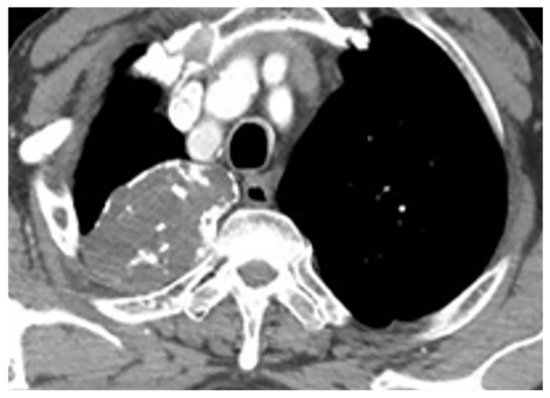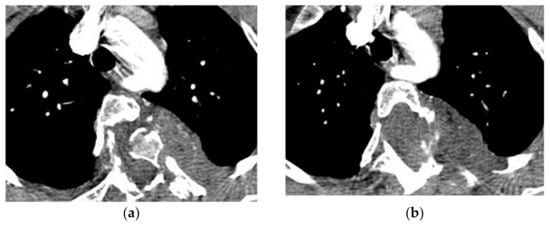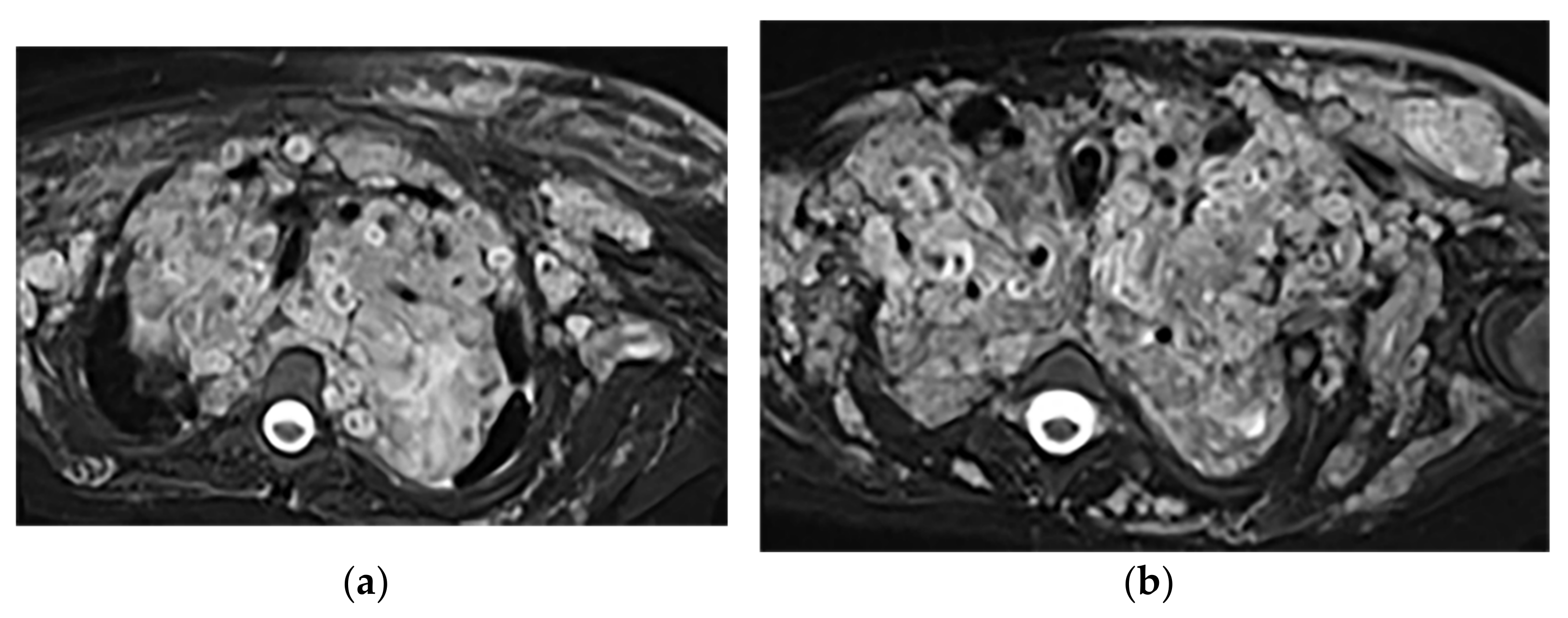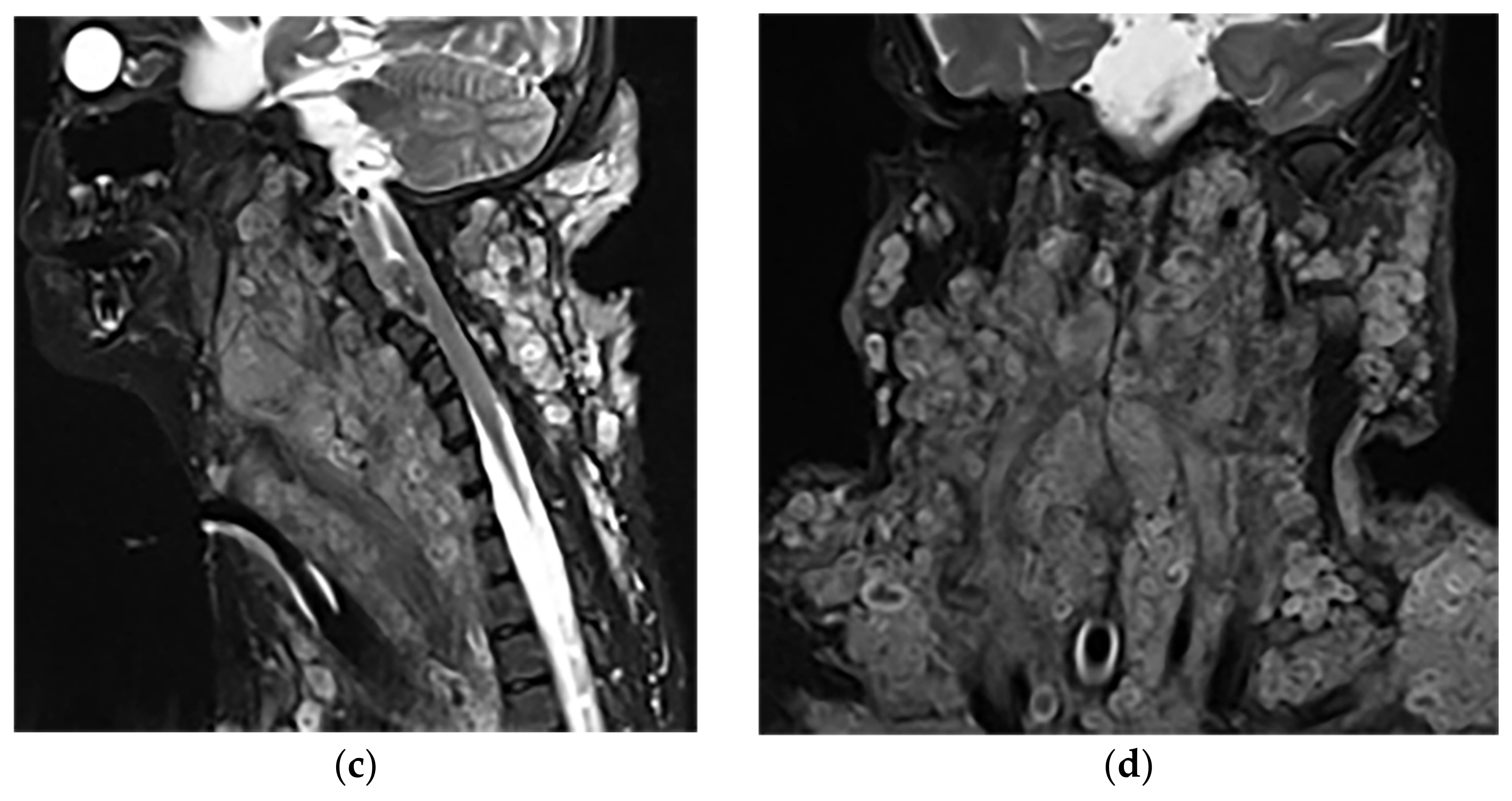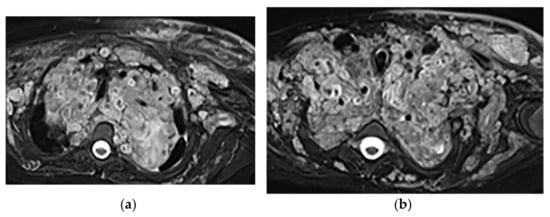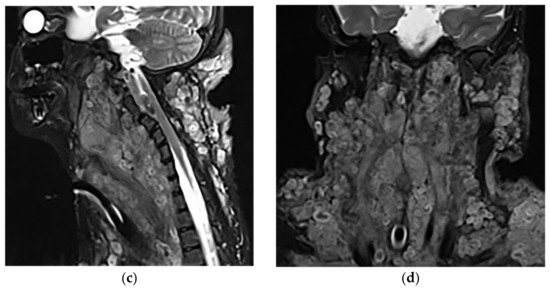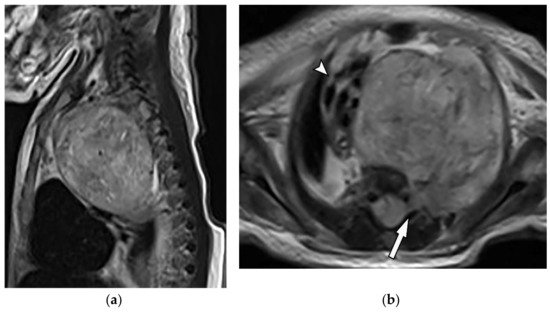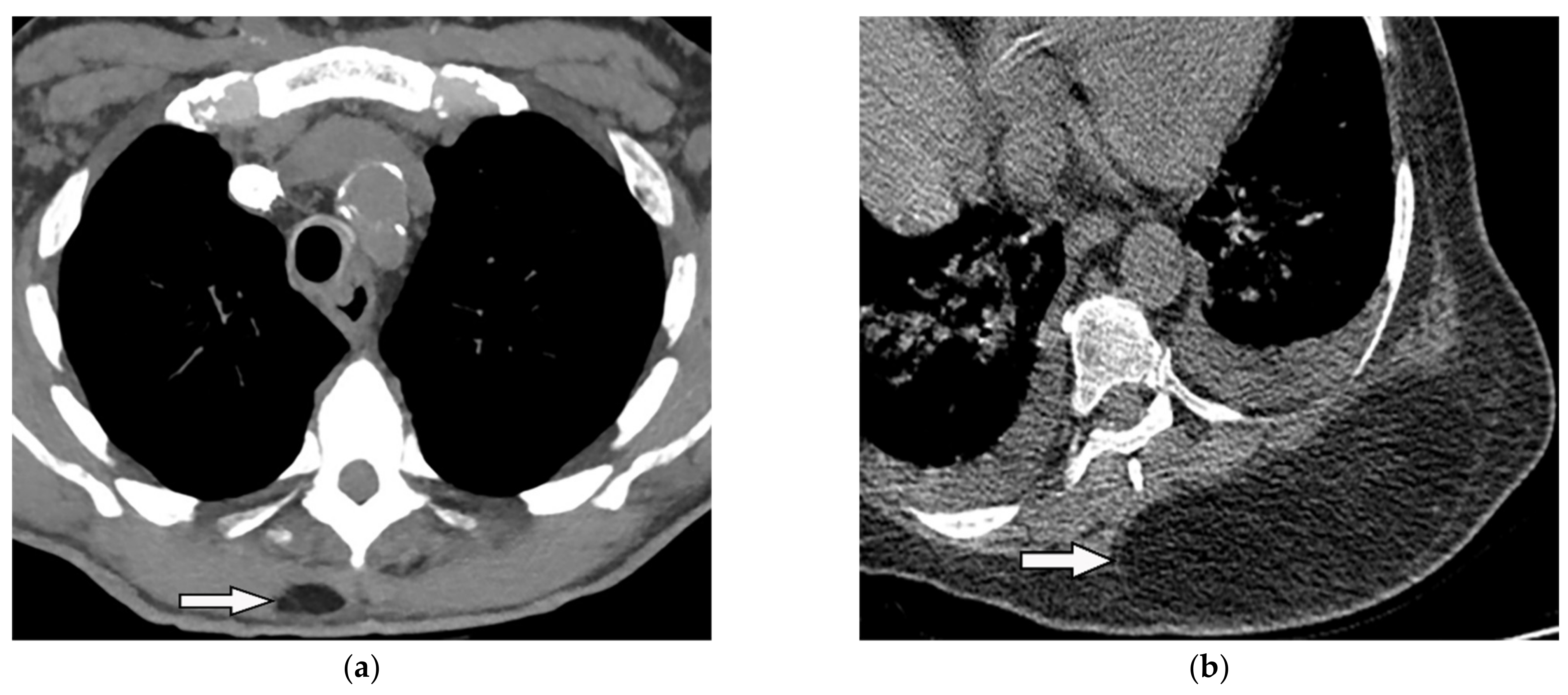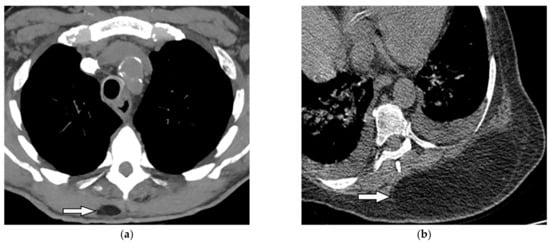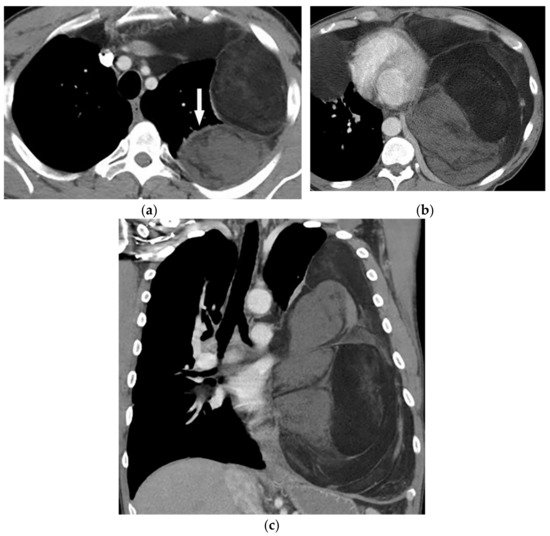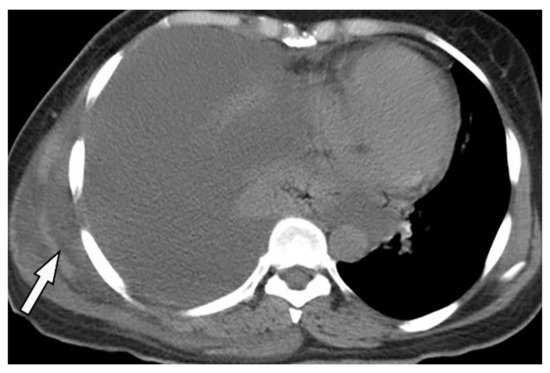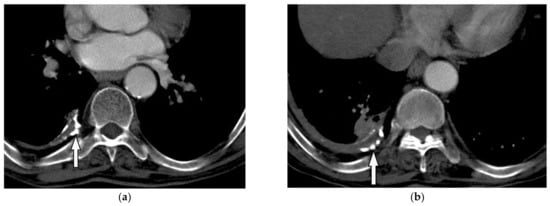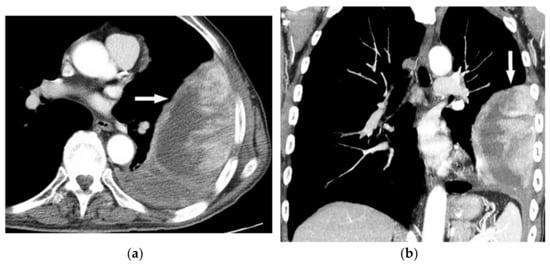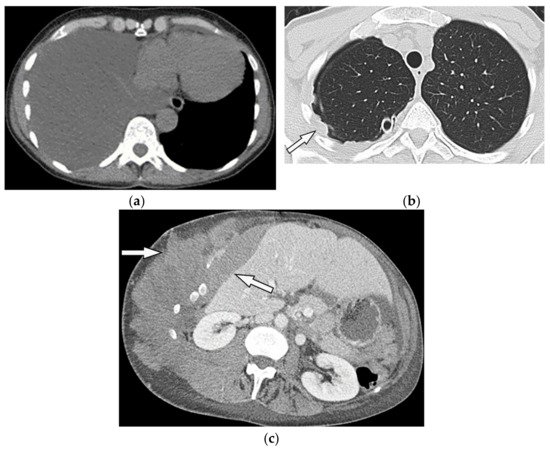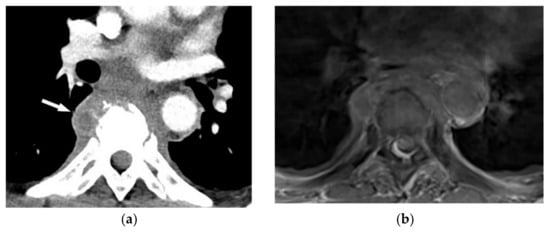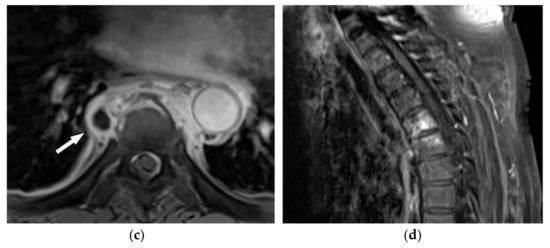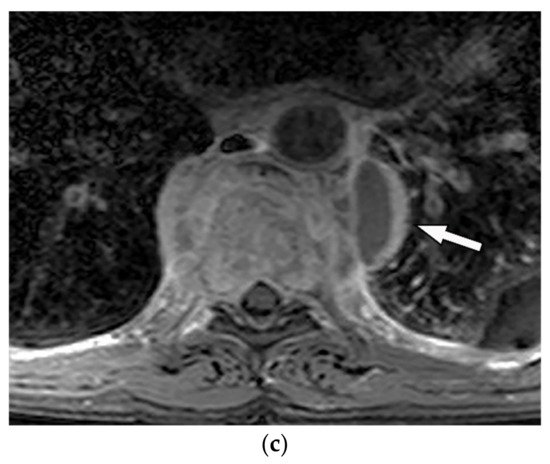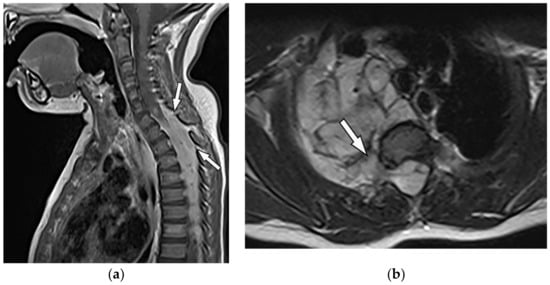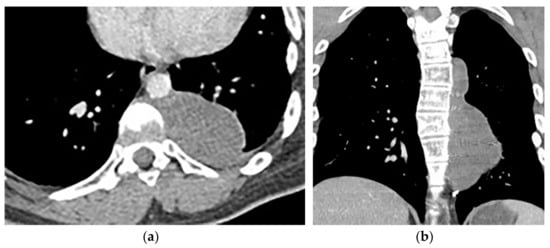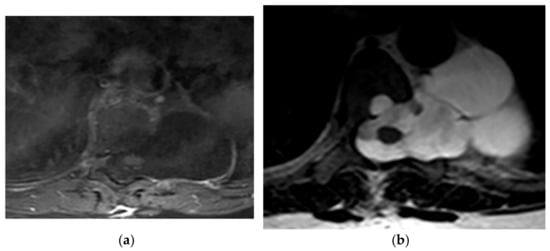A heterogeneous group of tumors can affect the posteromedial chest wall. They form diverse groups of benign and malignant (primary or secondary) pathologies that can arise from different chest wall structures, i.e., fat, muscular, vascular, osseous, or neurogenic tissues. Chest radiography is very nonspecific for the characterization of chest wall lesions. The modality of choice for the initial assessment of the chest wall lesions is computed tomography (CT). More advanced cross-sectional modalities such as magnetic resonance imaging (MRI) and positron emission tomography (PET) with fluorodeoxyglucose are usually used for further characterization, staging, treatment response, and assessment of recurrence. A systematic approach based on age, clinical history, and radiologic findings is required for correct diagnosis. It is essential for radiologists to be familiar with the spectrum of lesions that might affect the posteromedial chest wall and their characteristic imaging features. Although the imaging findings of these tumors can be nonspecific, cross-sectional imaging helps to limit the differential diagnosis and determine the further diagnostic investigation (e.g., image-guided biopsy). Specific imaging findings, e.g., location, mineralization, enhancement pattern, and local invasion, occasionally allow a particular diagnosis.
1. Introduction
Chest wall tumors are uncommon causes of thoracic neoplasms, which are less common than soft tissue or bony neoplasms elsewhere. Unfamiliarity with the complex posteromedial chest wall anatomy and radiologic features of related neoplasms is a diagnostic dilemma for radiologists
[1]. These tumors are heterogeneous with nonspecific clinical manifestations and different imaging characteristics, which make their diagnosis challenging. Either a benign or malignant nature and primary or secondary origin are probable
[2][3][4][2,3,4]. Primary chest wall neoplasms originate from chest wall structures, e.g., bony thorax, cartilage, muscle, fat, blood vessels, and nerve sheet
[3][5][3,5]. Secondary chest wall neoplasms include direct invasion from adjacent malignancies (lung or breast carcinomas) or distant metastasis
[2].
The posteromedial aspect of the chest wall has complex anatomy due to the presence of intercostal nerves, sympathetic chain, and vascular structures. Many neoplasms originate from these structures
[6]. Some of them may be almost exclusive to this location. Neurogenic tumors are more commonly arising from the posteromedial chest wall as they originate from autonomic ganglia, paraganglia, or nerve sheets. So, they account for the majority of lesions found in the posterior mediastinum and chest wall
[7]. Many of these lesions have specific imaging characteristics that help make precise diagnoses and avoid invasive sampling. In other conditions with nonspecific imaging appearance, cross-sectional imaging plays an essential role in limiting the differential diagnosis and defining the further investigation, e.g., imaging-guided biopsy. So, it is crucial for radiologists to be familiar with these diverse group of lesions and their imaging characteristics
[4][8][4,8].
2. Spondylodiskitis
Spondylodiskitis is an infectious process that initially affects the anterior portion of the vertebral bodies and then spreads to the adjacent intervertebral disk via medullary spaces [9]. Staphylococcus aureus is the most common cause of pyogenic spondylodiskitis, which commonly presents as a single-level lumbar involvement of two vertebral bodies and intervertebral disk. Tuberculosis spondylodiskitis, the most common non-pyogenic spine infection, more commonly involves the thoracic spine [9][10].
2.1. Pyogenic Spondylodiskitis
Pyogenic spondylodiskitis presents with loss of vertebral end plate definition and marrow edema. It displays hypointensity on T1-weighted images and hyperintensity on T2-weighted and STIR images. Various types of disk post-contrast enhancement (e.g., homogenous, patchy, and peripheral) may be detected [9]. Abscess or phlegmons demonstrate heterogeneous mixed signal intensity on both T1-weighted and T2-weighted images, with probable spinal cord compression. Rim-like or diffuse post-contrast enhancement are usually seen within these soft tissues. Diffusion weighted imaging (DWI) is valuable for differentiating the abscess from other paravertebral lesions (
Spondylodiskitis is an infectious process that initially affects the anterior portion of the vertebral bodies and then spreads to the adjacent intervertebral disk via medullary spaces [39]. Staphylococcus aureus is the most common cause of pyogenic spondylodiskitis, which commonly presents as a single-level lumbar involvement of two vertebral bodies and intervertebral disk. Tuberculosis spondylodiskitis, the most common non-pyogenic spine infection, more commonly involves the thoracic spine [39,40].
2.1. Pyogenic Spondylodiskitis
Pyogenic spondylodiskitis presents with loss of vertebral end plate definition and marrow edema. It displays hypointensity on T1-weighted images and hyperintensity on T2-weighted and STIR images. Various types of disk post-contrast enhancement (e.g., homogenous, patchy, and peripheral) may be detected [39]. Abscess or phlegmons demonstrate heterogeneous mixed signal intensity on both T1-weighted and T2-weighted images, with probable spinal cord compression. Rim-like or diffuse post-contrast enhancement are usually seen within these soft tissues. Diffusion weighted imaging (DWI) is valuable for differentiating the abscess from other paravertebral lesions ( Figure 1) [9][11].
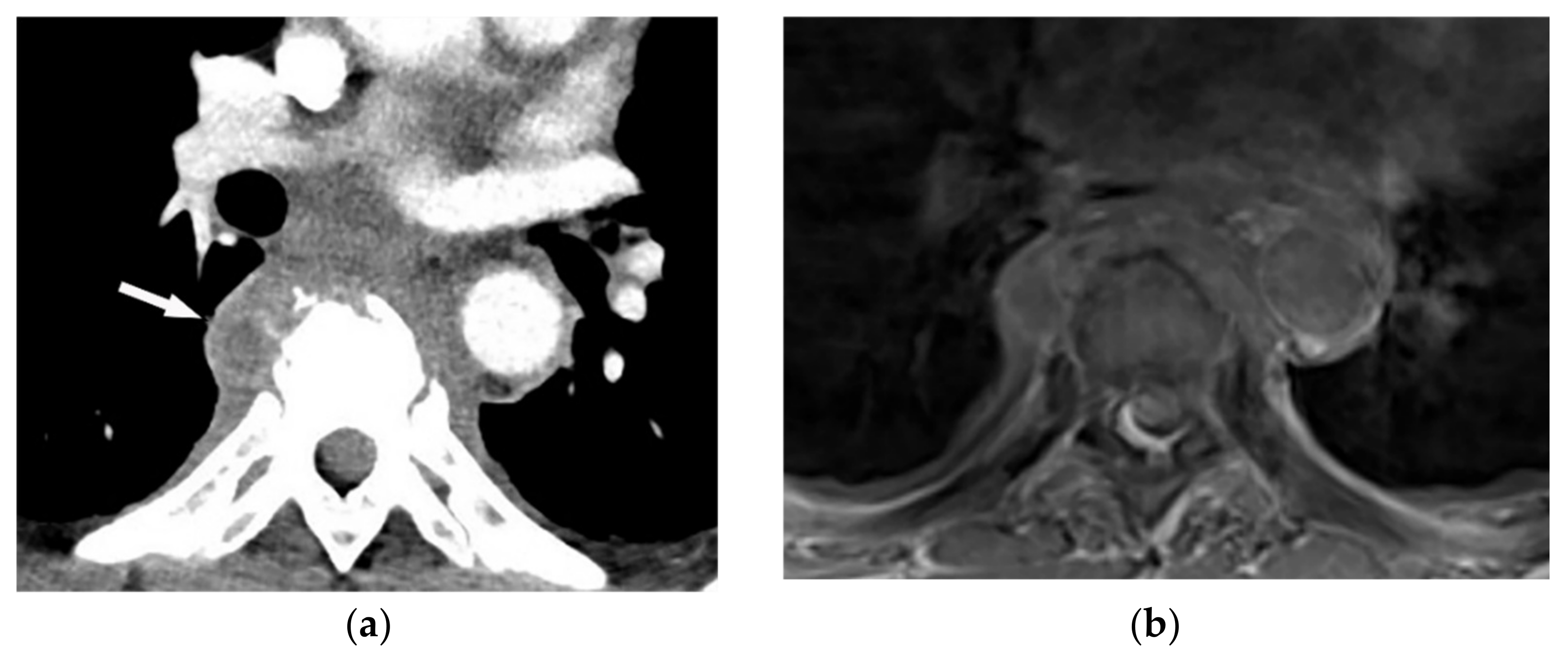
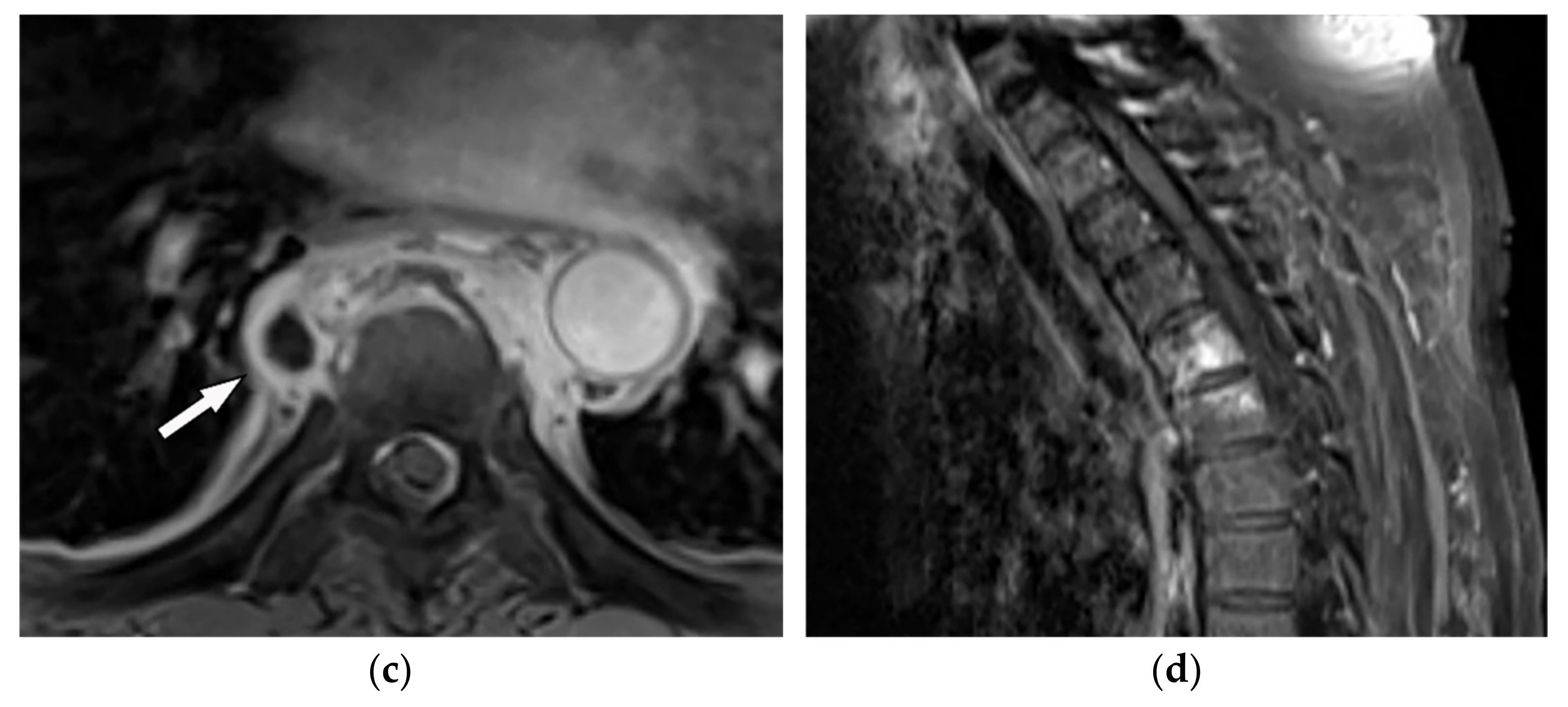 2
2 A 71-year-old man with back pain and fever. The contrast-enhanced CT in axial plane (
) demonstrates para-spinal soft tissue mass (arrow) with adjacent vertebral body cortical destruction. Axial pre-contrast (
) and post-contrast T1WFS (
) images at the level of T6-T7 show hypo to isointense paravertebral soft tissue mass with peripheral rim enhancement (arrow) after injection of gadolinium suggestive for paravertebral abscess formation. Sagittal STIR (
d) image shows adjacent subchondral bone marrow edema as hypersignal intensity. Posterior elements are spared with normal signal intensity. Aspiration was performed and culture was compatible for brucellosis.
2.2. Tuberculosis Spondylodiskitis
Tuberculosis spondylodiskitis has a more gradual and chronic clinical course, which leads to multi-level involvement and paravertebral cold abscess formation with well-circumscribed thin wall. Subligamentous spread of infection to adjacent vertebral levels, relative preservation of intervertebral disk, and kyphotic angulation (gibbous deformity) are other imaging findings. CT scan is more sensitive in delineating calcification within paravertebral cold abscess, end plate erosion, and bony fragment visualization () image shows adjacent subchondral bone marrow edema as hypersignal intensity. Posterior elements are spared with normal signal intensity. Aspiration was performed and culture was compatible for brucellosis.
2.2. Tuberculosis Spondylodiskitis
Tuberculosis spondylodiskitis has a more gradual and chronic clinical course, which leads to multi-level involvement and paravertebral cold abscess formation with well-circumscribed thin wall. Subligamentous spread of infection to adjacent vertebral levels, relative preservation of intervertebral disk, and kyphotic angulation (gibbous deformity) are other imaging findings. CT scan is more sensitive in delineating calcification within paravertebral cold abscess, end plate erosion, and bony fragment visualization (
Figure 2) [9][12].
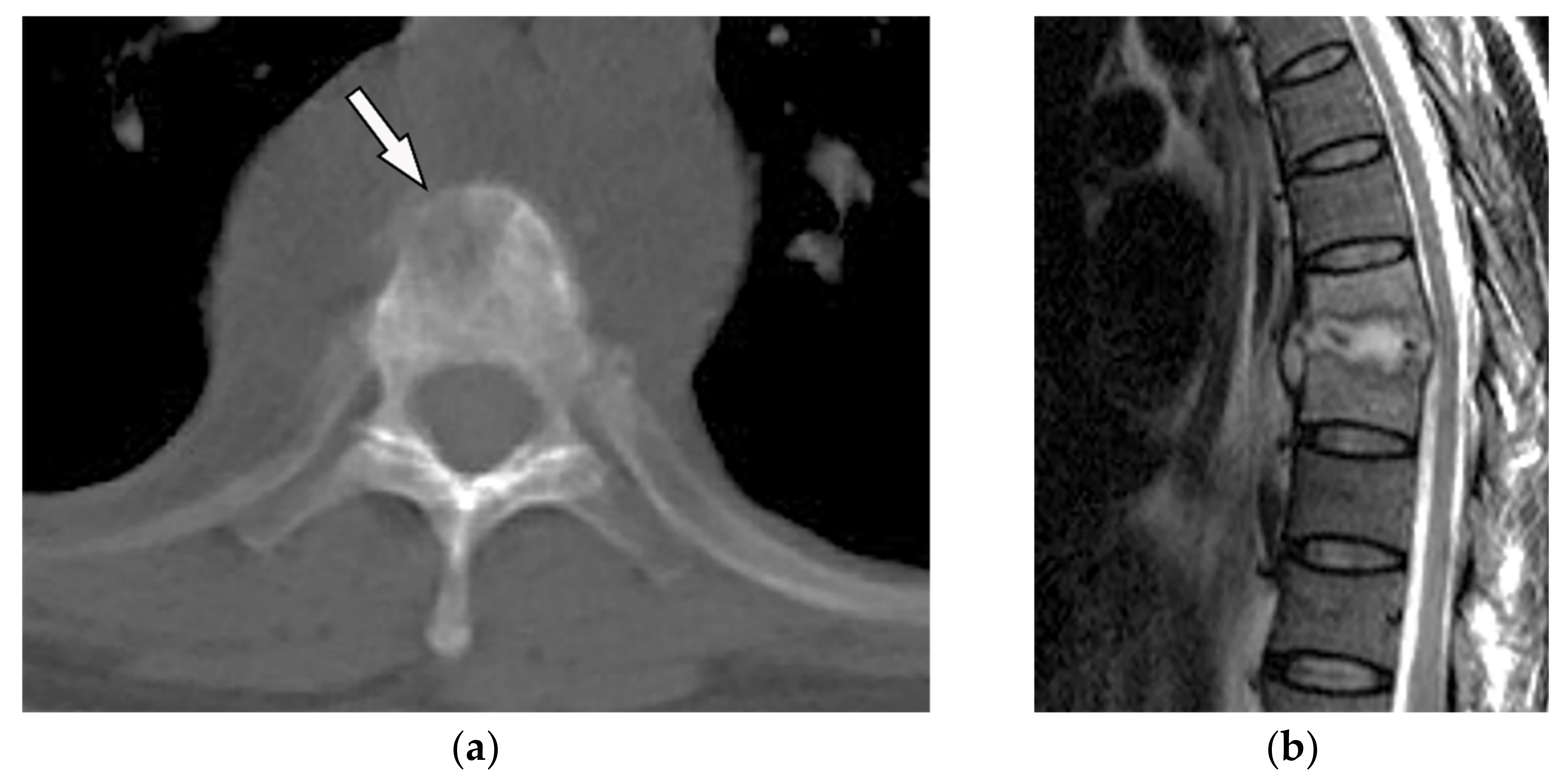
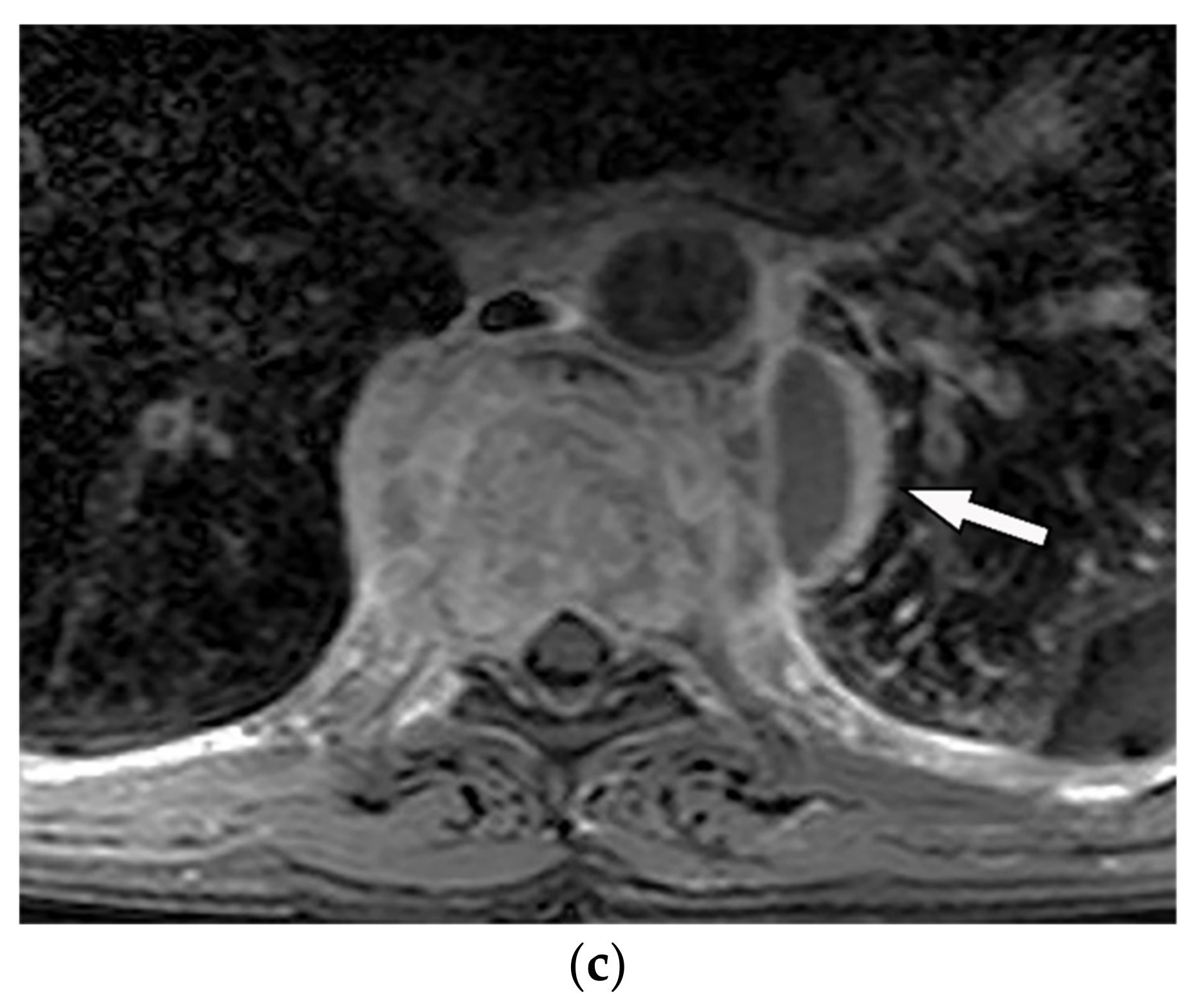 13
13 A 65-year-old man with fever, weight loss, and night sweeting. The non-contrast-enhanced CT (bone window) in axial plane (
) shows paraspinal soft tissue mass with erosion of right lateral aspect of adjacent vertebral body. Sagittal T2W image of another patient with the same pathology (
) shows hypersignal intensity within T8-T9 vertebral bodies with also intervertebral disc destruction and narrowing of spinal canal pushing the spinal cord posteriorly. Axial T1WFS + C (
c) identified the enhancing paraspinal mass with peripheral rim enhancement (arrow) in its left posteromedial side, which is suggestive of abscess formation. Culture of aspirated pus under guide of CT was compatible with tuberculosis infection.
) identified the enhancing paraspinal mass with peripheral rim enhancement (arrow) in its left posteromedial side, which is suggestive of abscess formation. Culture of aspirated pus under guide of CT was compatible with tuberculosis infection.
3. Soft-Tissue Tumors and Tumor-Like Lesions
3.1. Primary Neurogenic Lesions
Neurogenic tumors of the chest wall can arise from the intercostal nerve, spinal nerve roots, and even from the distal branch of the brachial plexus. They consist of benign and malignant groups, including Neurofibroma, Schwannoma, and malignant peripheral nerve sheet tumors (
3.1. Primary Neurogenic Lesions
Neurogenic tumors of the chest wall can arise from the intercostal nerve, spinal nerve roots, and even from the distal branch of the brachial plexus. They consist of benign and malignant groups, including Neurofibroma, Schwannoma, and malignant peripheral nerve sheet tumors (
Table 13. Imaging manifestations of posteromedial chest wall soft-tissue tumors.
| Tumor Type |
Imaging Findings |
| CT |
MRI |
| Primary Neurogenic Tumors |
| Schwannoma |
Well-defined mass with homogenous attenuation, “fat-split” sign, internal calcification in long-standing schwannomas, postcontrast enhancement except for areas of necrosis. |
T1W: iso or slightly hyperintense; T2W: significantly hyperintense |
| Neurofibroma |
Well-circumscribed mass with smooth margin and soft tissue attenuation, possible internal calcifications, rib erosion, neural foramina widening because of tumor extension along with the spinal nerve roots. |
T2W, T1WFS + C: so-called “target sign” appearance: hyperintense rim and hypointense center |
| Neuroblastoma [7][13][14] |
Ill-defined paravertebral soft tissue mass with heterogeneous attenuation with internal calcification in at least 30% of cases (spotty calcification). |
T1W: hyposignal
T2W: hyperintense
T1WFS + C: heterogeneous enhancement
Calcification has a signal void in all sequences |
| Ganglioneuroma [7][13][14] |
Homogenous or heterogeneous attenuation with internal calcification in 25% of cases. |
T1W, T2W: intermediate signal with the curvilinear or nodular low signal band making the whorled appearance |
| Lipomatosis Tumors |
| Lipoma |
Homogenous similar attenuation to macroscopic fat with approximate HU: −100. |
T1W, T2W: signal intensity identical to subcutaneous fat
T1WFS + C: no enhancement (mild enhancement can be visible for septa < 2 mm thickness) |
| Liposarcoma |
A heterogeneous mass mixture of fat and soft tissue: higher attenuation than normal fat (hypercellularity), necrosis, and calcification in myxoid subtype.
Attenuation similar to fat in well-differentiated subtype.
Thick septa, enhancing solid component. |
T1W: variable
hyperintense (myxoid liposarcoma), hypointense (well-differentiated), and intermixed hyper and hypointense (dedifferentiated subtype)
T2W: hyperintense (myxoid liposarcoma and dedifferentiated subtype)
T1WFS + C: variable enhancement |
| Others |
| Rhabdomyosarcoma |
Invasive, destructive homogenous mass with no mineralization and rapid growth with adjacent soft tissue and bone invasion. |
T1W: isointense
T2W: hyperintense with hypointense areas reflecting area of necrosis (alveolar and pleomorphic subtypes)
T1WFS + C: homogenous or ring-like enhancement |
| Mesothelioma |
Circumferential pleural thickening, bony or cartilaginous differentiation, unilateral pleural effusion, interlobular septal thickening, tumoral extension, thoracic and extrathoracic metastasis. |
T1W: unilateral hyperintense pleural effusion, iso to slightly hyperintense pleural thickening
T2W: moderately hyperintense
T1WFS + C: typical enhancement is expected |
| Extramedullary Plasmacytoma |
Soft tissue masses with nonspecific imaging manifestations.
Larger lesions show aggressive behavior such as infiltration, destruction, and encasement. |
T1W: isointense
T2W: iso to hyperintense
T1WFS + C: variable enhancement (from mild to marked enhancement) |
3.1.1. Schwannoma
Imaging manifestations of posteromedial chest wall soft-tissue tumors.
Schwannoma is an encapsulated slow-growing peripheral nerve sheet neoplasm typically occurring in patients between 20–50 years old
[6][13][6,16]. Chest wall schwannomas arise from spinal nerve roots with a dumbbell shape appearance and extend through the course of intercostal nerves, paravertebral region, or spinal canal
[7][14][7,43].
Schwannoma presents a well-defined homogenous mass on CT scan with attenuation similar or less than muscle. The “Fat-split” sign caused by adjacent surrounding fat is indicative of its non-infiltrating growing pattern. It also shows remarkable post-contrast enhancement except for areas of necrosis or cystic changes (
Figure 314). On MR images, it has intensity equal to or slightly more than muscle on T1-weighted and marked hyperintensity on T2-weighted images. Scalloping or bony erosions might be the only radiographic manifestations reflecting its benign nature
[6][7][13][14][6,7,16,43].
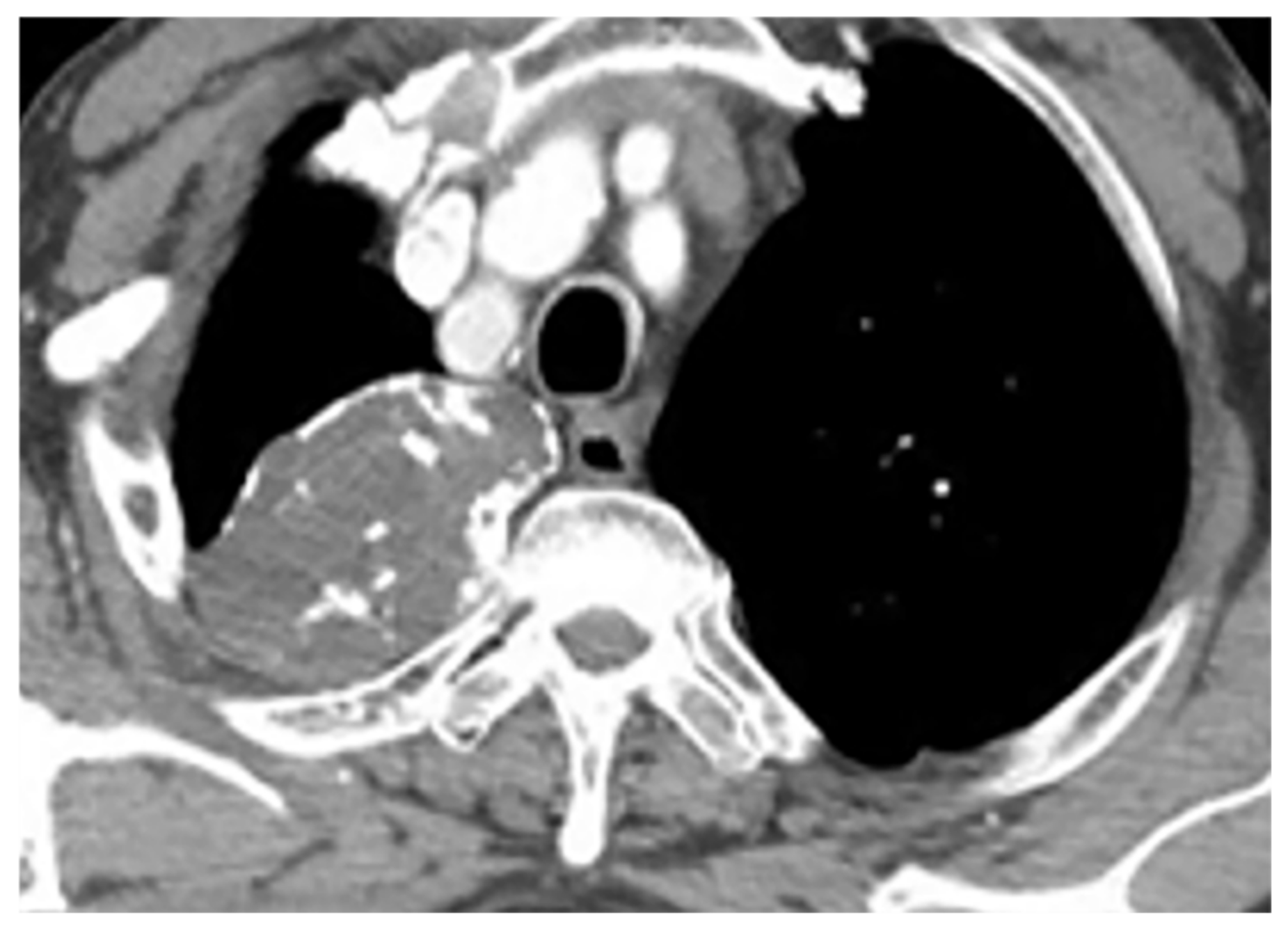
Figure 314. A 39-year-old woman with right vague chest pain. The contrast-enhanced axial CT demonstrates right-sided well-defined posterior mediastinal paraspinal mass with foci of calcifications within it. The round configuration is typical for peripheral nerve tumors. The attenuation is equal to chest wall muscles. Histopathological examination confirms Schwannoma.
3.1.2. Neurofibroma
A 39-year-old woman with right vague chest pain. The contrast-enhanced axial CT demonstrates right-sided well-defined posterior mediastinal paraspinal mass with foci of calcifications within it. The round configuration is typical for peripheral nerve tumors. The attenuation is equal to chest wall muscles. Histopathological examination confirms Schwannoma.
Neurofibroma is another slow-growing peripheral nerve sheet neoplasm that affects patients in their 20s to 30s with equal male and female prevalence. Localized Neurofibroma, which includes approximately 90% of cases, is not typically associated with neurofibromatosis type 1 (NF1). However, the majority of cases with plexiform type have underlying NF1
[7][13][7,16].
The main CT findings are well-circumscribed mass with smooth margin, soft tissue attenuation, possible internal calcifications, and adjacent rib erosion. Neural foraminal widening secondary to tumor extension can be accurately identified on multidetector CT (
Figure 415). “Target sign” appears on both T2-weighted and gadolinium-enhanced MR images. It is related to the peripheral abundant stromal matrix surrounding the high cellular center, presenting as hyperintense rim and hypointense center, respectively (
Figure 516 and
Figure 617)
[7][13][14][7,16,43].
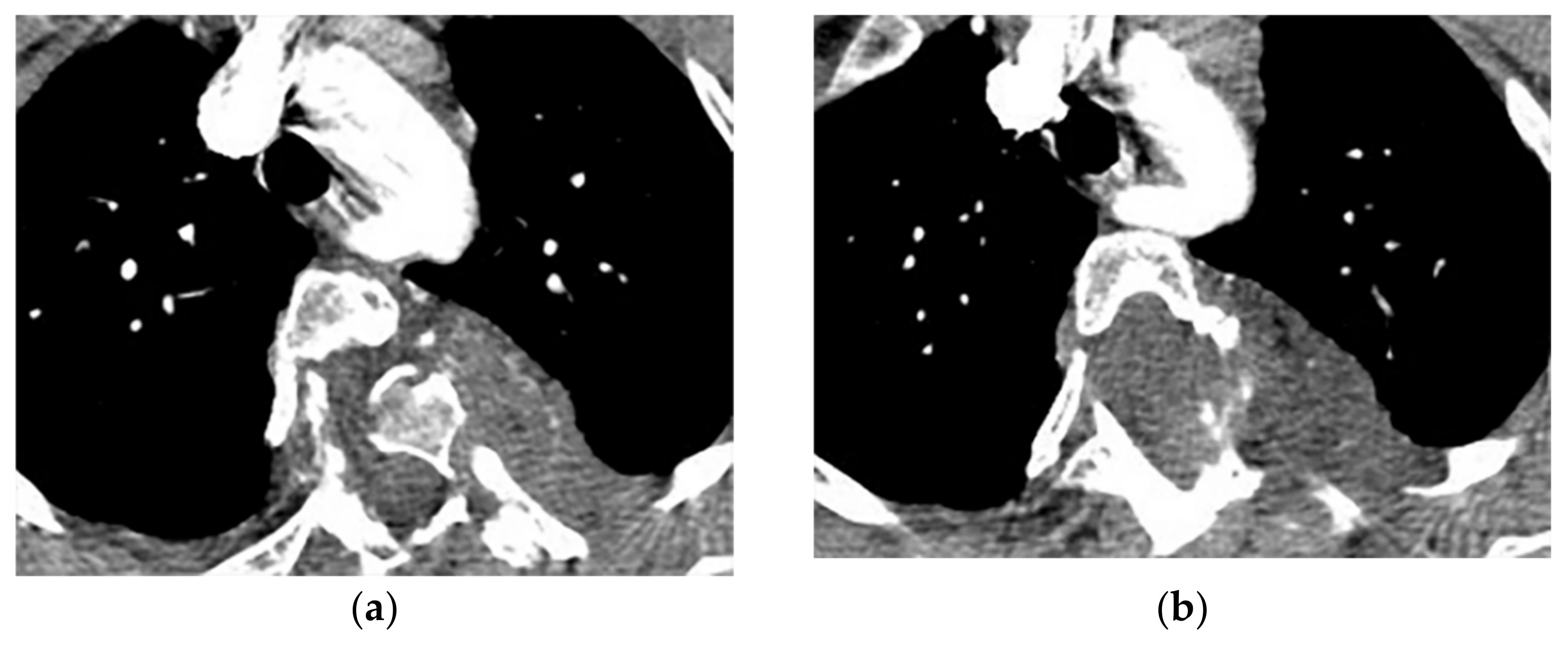
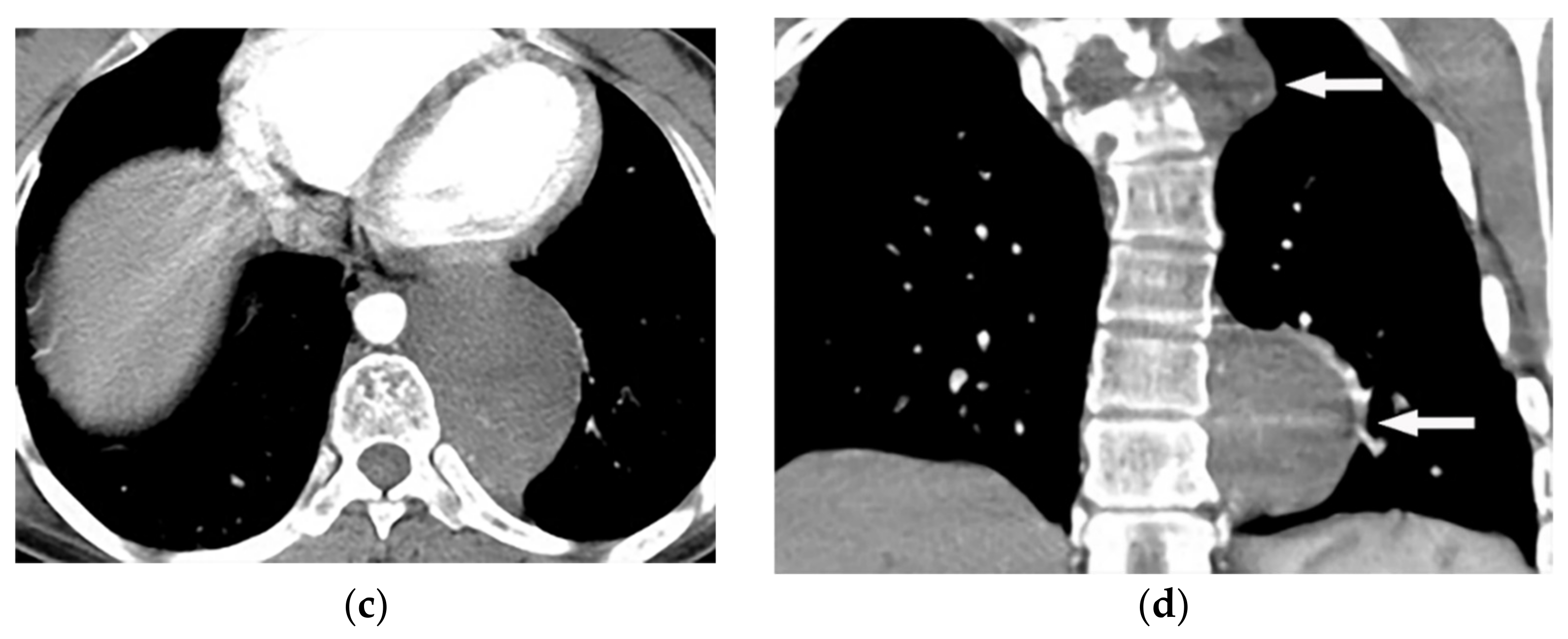
A 27-year-old male with scoliosis. Contrast-enhanced CT in the axial plane (soft tissue window) shows vertebral anomaly and dural ectasia. Left-sided well-defined lobular mass with the widening of adjacent neural foramen with intra- and extraspinal extension are offered (
d) shows scoliosis in upper thoracic vertebrae, associated with two well-defined homogenous masses (arrow) with similar appearance in upper and lower posterior mediastinum.
) shows scoliosis in upper thoracic vertebrae, associated with two well-defined homogenous masses (arrow) with similar appearance in upper and lower posterior mediastinum.
A 31-year-old woman with incidental findings. The axial T2W (
) images show a sharply marginated lobular mass with heterogeneous peripheral hyper signal intensity in T2W, and internal hyper intensity of cystic changes, extending through the right-sided neural foramina (arrow). It has heterogeneous enhancement after contrast administration (
b); no adjacent vertebral body scalloping was found. ); no adjacent vertebral body scalloping was found.
A 34-year-old man, with a case of neurofibromatosis type 1. The axial T2W images (
) show multiple confluent infiltrative paraspinal masses within the neck and upper thorax along the course of sympathetic chain and nerves with high signal intensity and central focus of hypointensity (target sign) surrounding the mediastinal vessels that are typical for plexiform Neurofibroma. Sagittal T2W (
d) images show the extensive infiltrative nature of this lesion with multi-compartment involvement and extension to pharyngeal space and pressure effect over cervical and thoracic vertebrae.
3.1.3. Neuroblastoma
Thoracic Neuroblastoma is a non-encapsulated tumor that arises from extra-adrenal sympathetic ganglia. The mediastinum is the second most common tumor location after the abdomen that has a better prognosis than other sites.
Neuroblastoma appears as an ill-defined paravertebral soft tissue mass on a CT scan with heterogeneous attenuation caused by hemorrhage, necrosis, or cystic degeneration. Internal calcification is seen at least in 30% of cases [7][13]. MRI shows irregular margin with possible local invasion to the spinal canal, presenting T1-hypointensity and T2-hyperintensity with heterogeneous enhancement. Calcification has a signal void in all sequences ( ) images show the extensive infiltrative nature of this lesion with multi-compartment involvement and extension to pharyngeal space and pressure effect over cervical and thoracic vertebrae.
3.1.3. Neuroblastoma
Thoracic Neuroblastoma is a non-encapsulated tumor that arises from extra-adrenal sympathetic ganglia. The mediastinum is the second most common tumor location after the abdomen that has a better prognosis than other sites.
Neuroblastoma appears as an ill-defined paravertebral soft tissue mass on a CT scan with heterogeneous attenuation caused by hemorrhage, necrosis, or cystic degeneration. Internal calcification is seen at least in 30% of cases [7,16]. MRI shows irregular margin with possible local invasion to the spinal canal, presenting T1-hypointensity and T2-hyperintensity with heterogeneous enhancement. Calcification has a signal void in all sequences ( Figure 8). It is reported that tumors with higher metabolic activity on 18F-FDG PET/CT have lower overall survival [15][16]. Metaiodobenzylguanidine labeled as 123I (MIBG) is highly sensitive for detecting catecholamine-producing tumors like neuroblastoma [7][13].
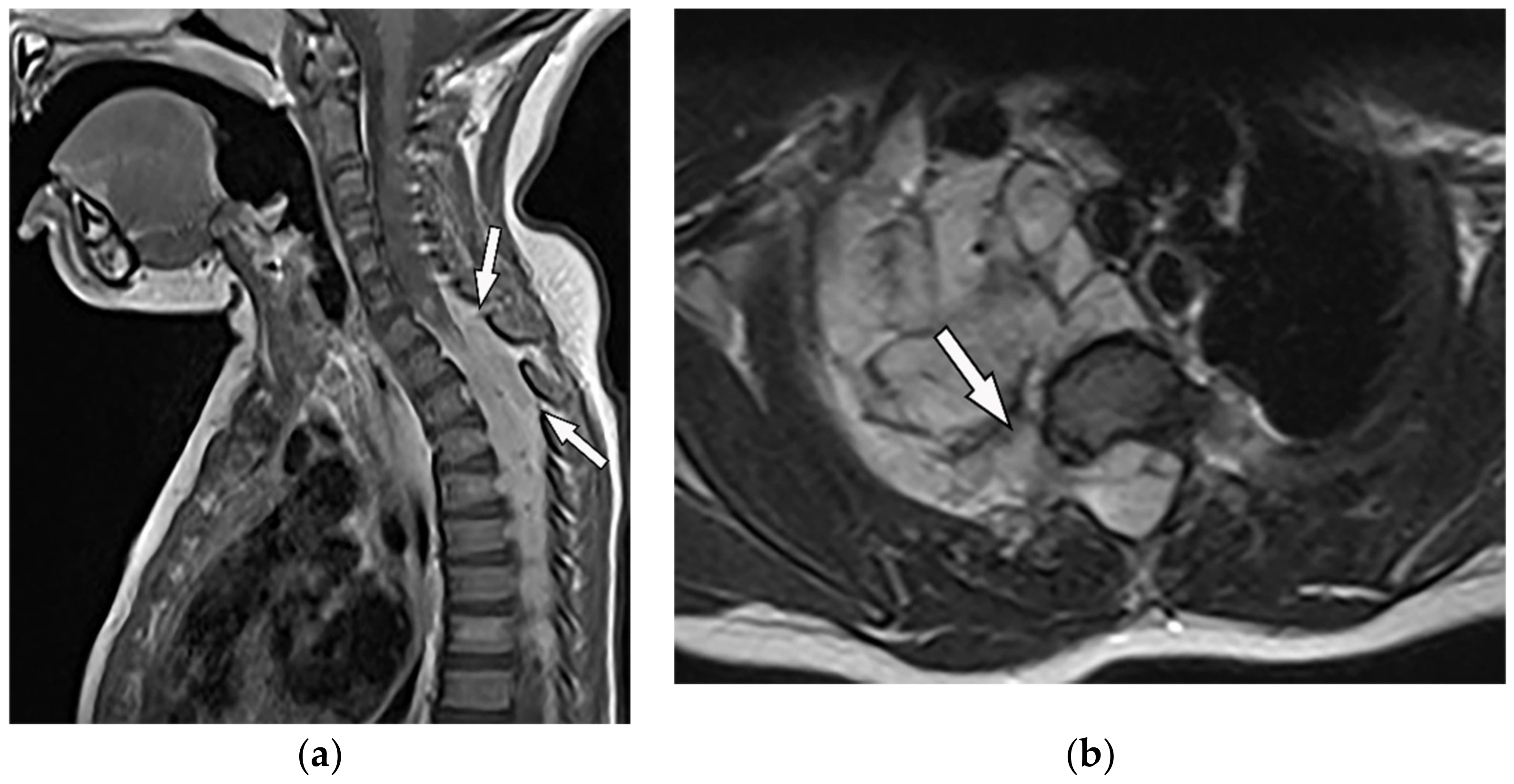 19
19 ). It is reported that tumors with higher metabolic activity on 18F-FDG PET/CT have lower overall survival [44,45]. Metaiodobenzylguanidine labeled as 123I (MIBG) is highly sensitive for detecting catecholamine-producing tumors like neuroblastoma [7,16]. A 6-year-old boy with posterior mediastinal mass with histopathological confirmation for Neuroblastoma. Axial (
) T2W shows an ill-defined lobulated group (arrow) with heterogeneous and hyper-intense signal intensity and area of a signal void within the posterior mediastinum. It has intracanal extension via right-sided neural foramina and extradural components at multiple levels. It displaced the spinal cord anteriorly, as shown in sagittal T1W after gadolinium administration (arrow) (
b).
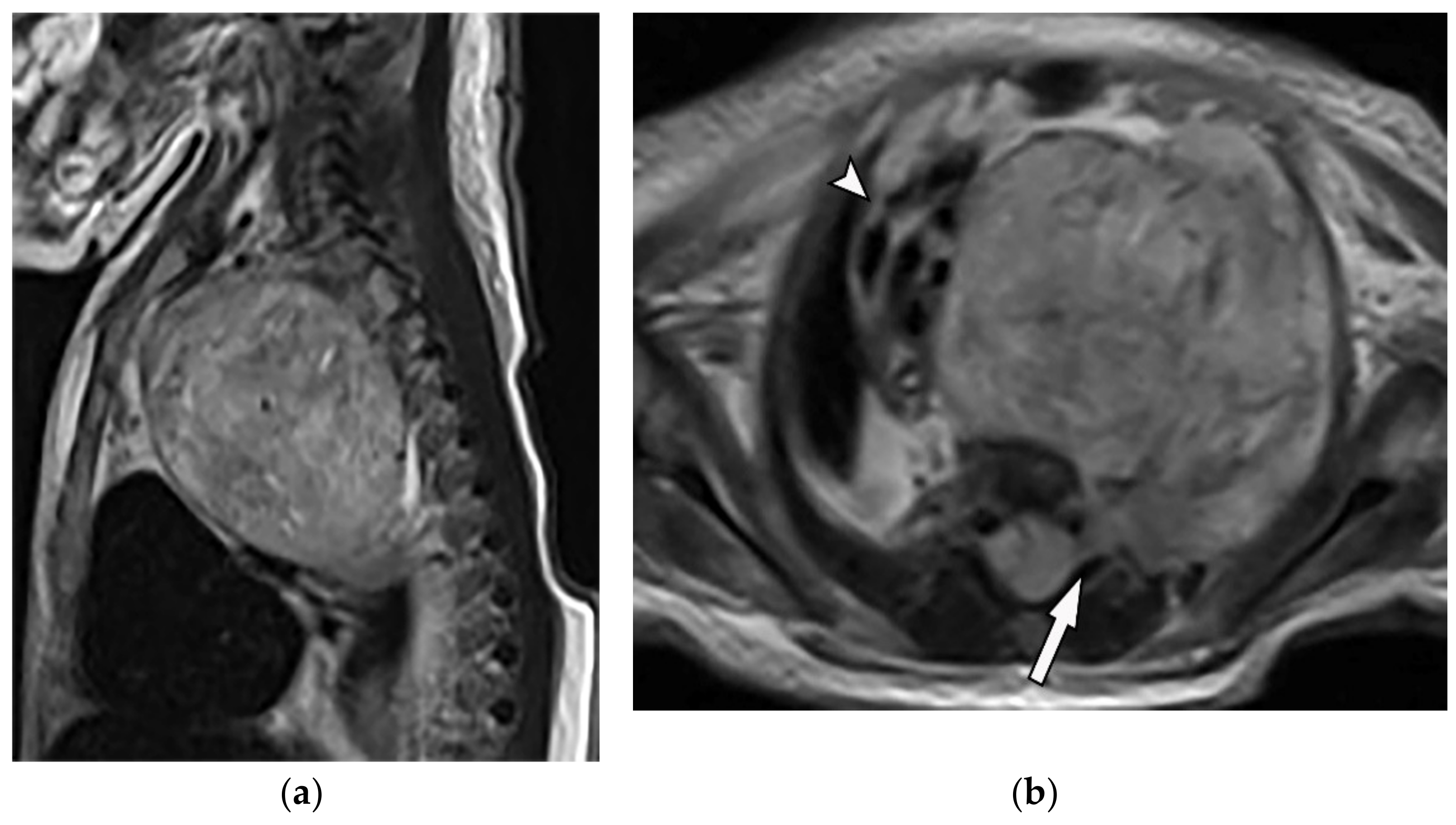
A 4-year-old girl with the opsomyoclonus-myoclonus syndrome. Sagittal (
b) T2W images show large lobulated paraspinal masses (arrowhead) crossing the midline within the posterior superior mediastinum. It shows heterogeneous and hyperintense signal intensity with internal foci of the signal void caused by calcification. It extends through the spinal canal via neural foramina (arrow). Right anterolateral displacement of mediastinal great vessels is also identified.
3.1.4. Ganglioneuroma
Ganglioneuromas are differentiated slow-growing neurogenic tumors originating from sympathetic ganglia that affect young patients. They appear as a paravertebral oval mass with a smooth border and vertical orientation following the sympathetic chain direction. Posterior mediastinum is the most common site of involvement of thoracic ganglioneuroma.
It has homogenous or heterogeneous attenuation on CT images with probable internal calcification (speckled, fine, or coarse). MR imaging displays lesions with intermediate signal intensity on both T1-weighted and T2-weighted images with curvilinear or nodular low signal bands, which form the whorled appearance () T2W images show large lobulated paraspinal masses (arrowhead) crossing the midline within the posterior superior mediastinum. It shows heterogeneous and hyperintense signal intensity with internal foci of the signal void caused by calcification. It extends through the spinal canal via neural foramina (arrow). Right anterolateral displacement of mediastinal great vessels is also identified.
3.1.4. Ganglioneuroma
Ganglioneuromas are differentiated slow-growing neurogenic tumors originating from sympathetic ganglia that affect young patients. They appear as a paravertebral oval mass with a smooth border and vertical orientation following the sympathetic chain direction. Posterior mediastinum is the most common site of involvement of thoracic ganglioneuroma.
It has homogenous or heterogeneous attenuation on CT images with probable internal calcification (speckled, fine, or coarse). MR imaging displays lesions with intermediate signal intensity on both T1-weighted and T2-weighted images with curvilinear or nodular low signal bands, which form the whorled appearance (
Figure 9) [7][13][14].
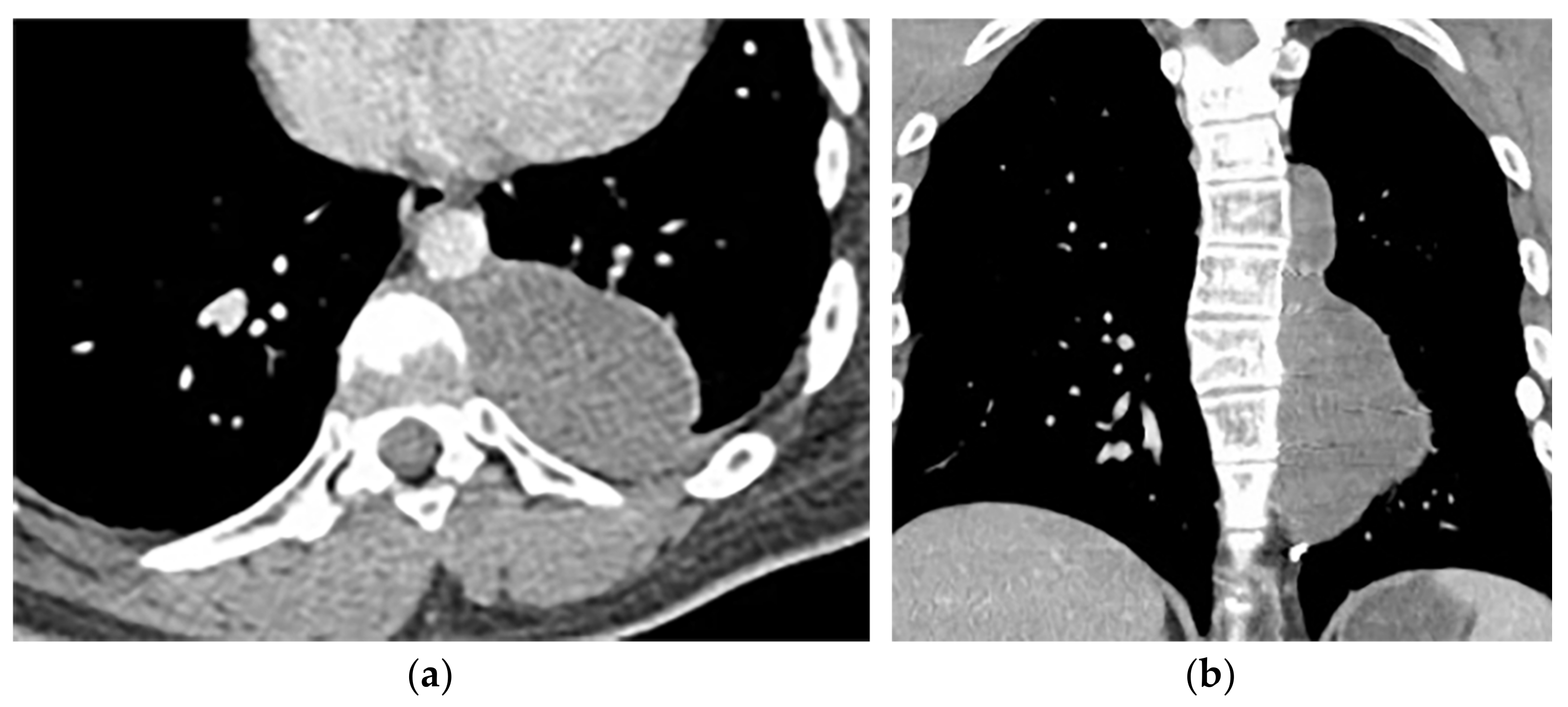
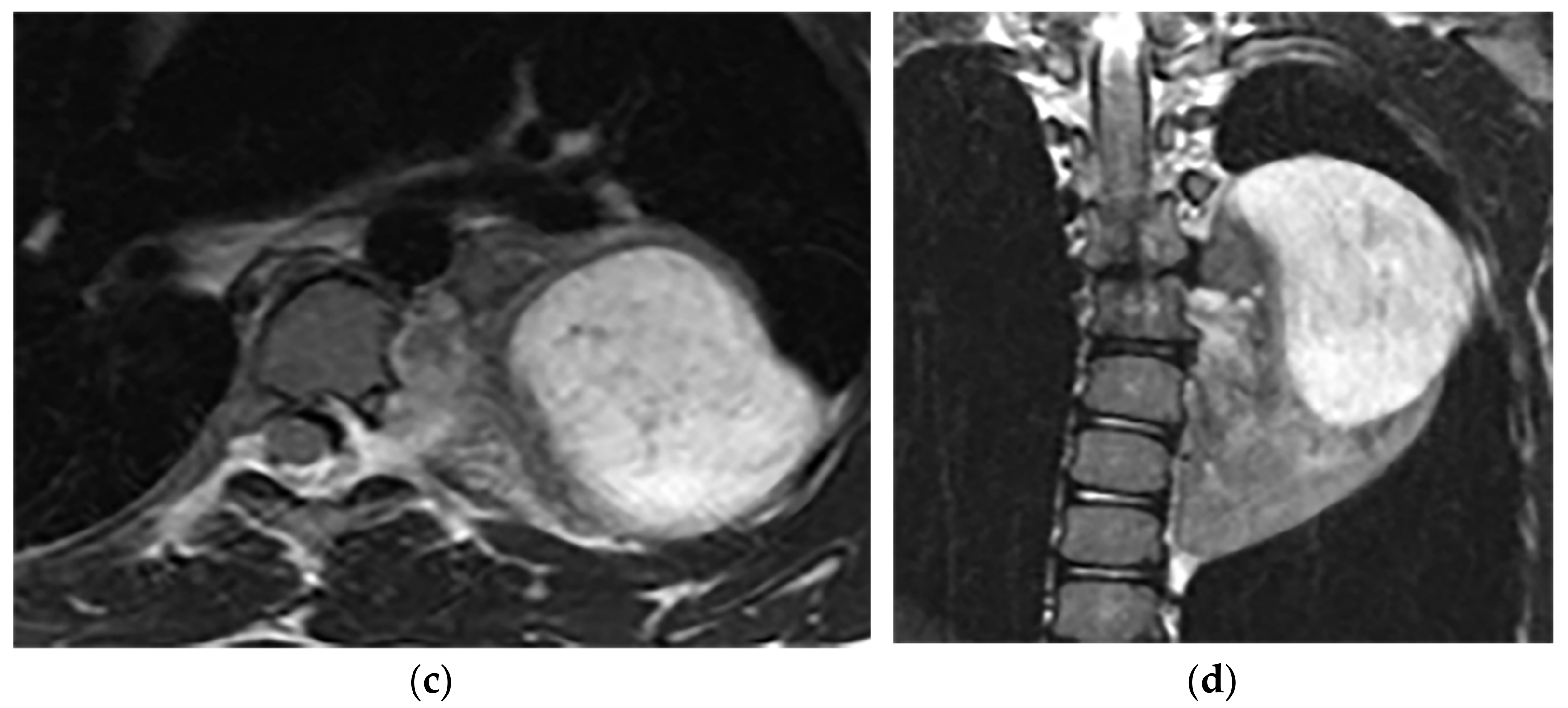 20
20 A 26-year-old man with incidental findings. The CT in axial and coronal views (
) shows a well-defined lobulated posterior mediastinal mass with homogenous attenuation and no significant enhancement after injection of contrast extending about five vertebral bodies length in the right posterior mediastinum with close contact to vertebral bodies, but with no vertebral erosion. Axial (
d) of another patient with the same pathology show well-defined elliptical posterior mediastinal mass with heterogeneously high signal intensity intermixed with internal patchy and linear hypointensity. It also erodes the left lateral aspect of the vertebral body but with no intradural extension. Vertical orientation is typical for sympathetic chain tumors.
3.2. Lateral Meningocele
Lateral thoracic Meningocele is a rare condition defined as herniation of meninges through the vertebral column defect or enlarged neural foramina. It can be unilateral or bilateral and is usually associated with neurofibromatosis type 1 () of another patient with the same pathology show well-defined elliptical posterior mediastinal mass with heterogeneously high signal intensity intermixed with internal patchy and linear hypointensity. It also erodes the left lateral aspect of the vertebral body but with no intradural extension. Vertical orientation is typical for sympathetic chain tumors.
3.2. Lateral Meningocele
Lateral thoracic Meningocele is a rare condition defined as herniation of meninges through the vertebral column defect or enlarged neural foramina. It can be unilateral or bilateral and is usually associated with neurofibromatosis type 1 (
Table 2). It is most common during the 4th to 5th decades of age, with female predominance [17].
4). It is most common during the 4th to 5th decades of age, with female predominance [46]. Table 24. Imaging manifestations of posteromedial chest wall soft-tissue tumor-like lesions.
| Tumor Type |
Imaging Findings |
| CT |
MRI |
| Neurogenic |
| Lateral Meningocele |
Well-circumscribed paravertebral mass with attenuation similar to CSF.
CT myelography: ipsilateral neural foramina enlargement communicating with subarachnoid space. |
T1W: hypointense
T2W: hyperintense (similar intensity to CSF)
T1WFS + C: lack of enhancement |
| Pseudomeningocele |
Differentiated from Meningocele by lack of dura wrapping. |
T1W: hypointense
T2W: hyperintense (similar intensity to CSF)
T1WFS + C: lack of enhancement [18] |
| Others |
| Extramedullary hematopoiesis |
Heterogeneous mass with internal foci of fat with lack of calcification. |
T1W, T2W: heterogeneous with internal foci of hyperintensity in old lesions (representative of fat), the intermediate intensity with subtle or no enhancement in active lesions |
| Asbestos-related pleural plaques |
Calcified or non-calcified focal pleural thickening, “Comet tail” appearance usually seen in lower lobes [19]. |
T1W: hypo to isointense
T2W: hypointense (due to fibrosis or calcification) [20] |
| Empyema necessitance |
Connection of pleural collection to extrapleural mass, soft tissue inflammation, rib destruction with periosteal reaction, and fluid collection. |
T1W: hypointense effusion and fluid collection
T2W: hyperintense effusion, increased thickness of extrapleural fat, and chest wall muscles with hyperintense on T2WFS
T1WFS + C: pleural and septal enhancement |
Lateral Meningocele presents as a well-circumscribed paravertebral mass with similar attenuation to CSF. CT myelography reveals ipsilateral neural foramina enlargement communicating with subarachnoid space. This is a key differentiation feature from Neurofibroma [16]. On MR imaging, lateral Meningocele has T1-hypointensity and T2-hyperintensity with no post-contrast enhancement identical to CSF ( Imaging manifestations of posteromedial chest wall soft-tissue tumor-like lesions.
Lateral Meningocele presents as a well-circumscribed paravertebral mass with similar attenuation to CSF. CT myelography reveals ipsilateral neural foramina enlargement communicating with subarachnoid space. This is a key differentiation feature from Neurofibroma [45]. On MR imaging, lateral Meningocele has T1-hypointensity and T2-hyperintensity with no post-contrast enhancement identical to CSF ( Figure 210) [21][17].
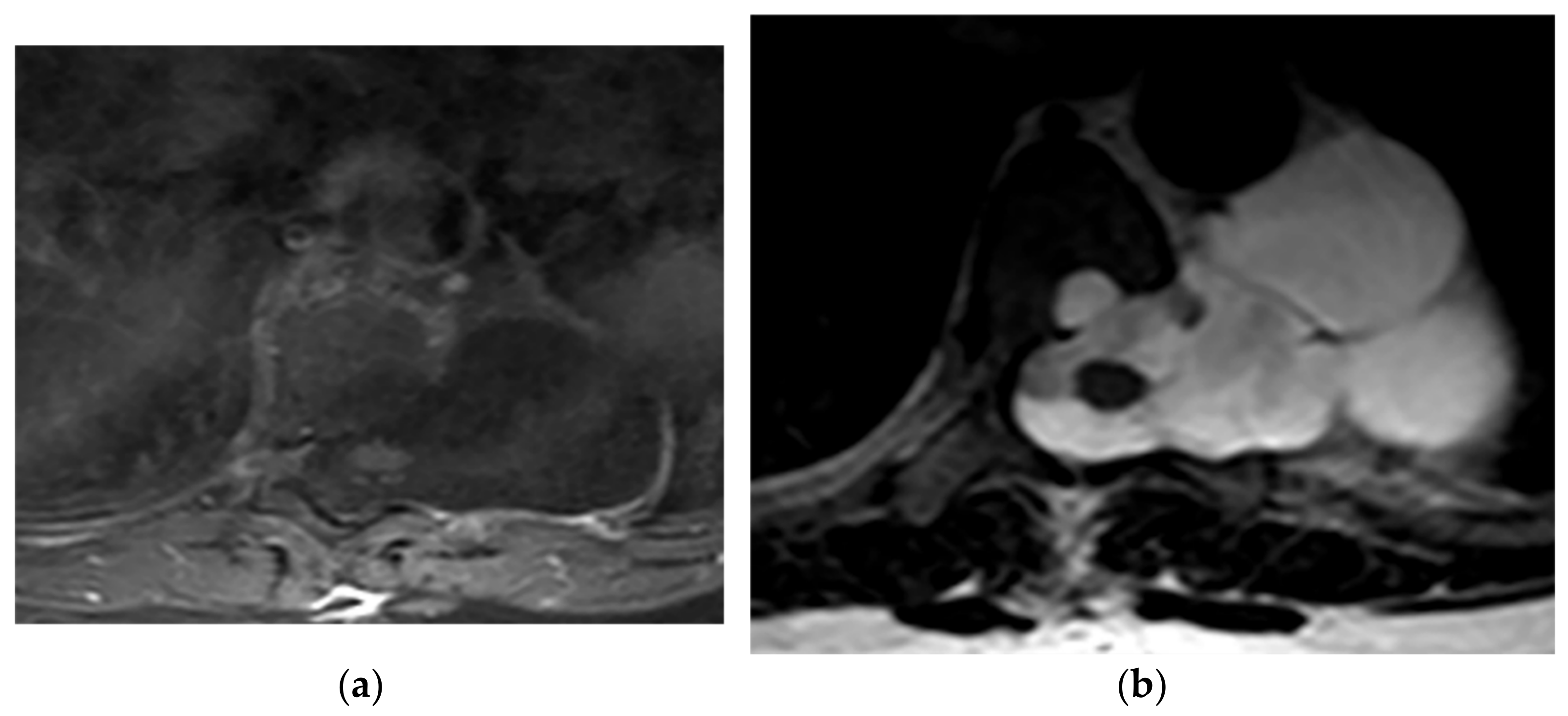
A 21-year-old man with Neurofibromatosis type 1. The axial T1FS (
b) show lateral expansion of CSF-filled sac through T6-T7 level with scalloping of the adjacent vertebral body. It has similar signal intensity to CSF in both T1W and T2W sequences and hypo and hypersignal intensity, respectively. No entrapped fat or neural elements were seen. Slightly anterior spinal cord displacement was also identified, which is compatible with lateral Meningocele.
3.3. Pseudomeningocele
) show lateral expansion of CSF-filled sac through T6-T7 level with scalloping of the adjacent vertebral body. It has similar signal intensity to CSF in both T1W and T2W sequences and hypo and hypersignal intensity, respectively. No entrapped fat or neural elements were seen. Slightly anterior spinal cord displacement was also identified, which is compatible with lateral Meningocele.
Pseudomeningocele or meningeal pseudocyst is an abnormal extradural CSF collection that communicates with the brain and spinal canal. It can be congenital (thoracolumbar), traumatic (cervical), or iatrogenic (laminectomy of the lumbar spine). Congenital Pseudomeningocele can be seen in Marfan syndrome or NF1
[21][25].
The Pseudomeningocele can be differentiated from Meningocele by lack of dura wrapping the collection. The absence of nerve roots within the CSF collection helps in identifying the brachial plexus Pseudomeningocele. On MR imaging, it has similar intensity to CSF with a lack of post-contrast enhancement (
Figure 1122)
[21][18][25,47]. The Pseudomeningocele can be differentiated from Meningocele by lack of dura wrapping the collection. The absence of nerve roots within the CSF collection helps in identifying the brachial plexus Pseudomeningocele. On MR imaging, it has similar intensity to CSF with a lack of post-contrast enhancement (
Figure 1122)
[21][18][25,47].

A 38-year-old man with a history of a remote motor vehicle collision. The axial (
b) contrast-enhanced CT show abnormal well-defined extraspinal fluid collection at the level C6-T1, which extends through the left neural foramina (lateral recess), communicating with CSF space. There is no edema, solid component, or abnormal enhancement within the mentioned collection or adjacent muscles. Regarding the history of trauma, a Pseudomeningocele diagnosis was made and was confirmed in MRI (not shown).
) contrast-enhanced CT show abnormal well-defined extraspinal fluid collection at the level C6-T1, which extends through the left neural foramina (lateral recess), communicating with CSF space. There is no edema, solid component, or abnormal enhancement within the mentioned collection or adjacent muscles. Regarding the history of trauma, a Pseudomeningocele diagnosis was made and was confirmed in MRI (not shown).
4. Lipomatosis Tumors
Radiologic characteristics of lipomatosis tumors are summarized in
3.Chest wall fatty tumors are relatively common, and lipoma is the most frequent. It is a well-defined mesenchymal tumor arising from adipose tissue usually seen in patients between 50–70 years old. Most chest wall lipomas are located deeply, involve intramuscular or intermuscular layers, and show larger size with less distinct borders than superficial ones
[1][8][13][22][1,8,16,50].
On multidetector CT scan, lipomas are homogenous and have similar attenuation to macroscopic fat with approximate −100 HU radiodensity (
Figure 123); other non-adipose components such as calcification and septa might also be seen. On MR imaging, signal intensity is identical to subcutaneous fat on T1-weighted and T2-weighted images. It typically does not enhance gadolinium-enhanced MR images except for septa with less than 2 mm thickness
[8][13][22][23][8,16,50,51].
A 34-year-old man, with a case of SVC thrombosis with incidental finding. (
) Non-contrast-enhanced CT in axial plane demonstrates well-circumscribed lesion in the right posteromedial aspect of the chest wall with similar attenuation to subcutaneous fat with no internal septa. Multiple collaterals are also shown in the anterior aspect of the chest wall, maybe formed due to underlying SVC occlusion. (
b) Axial plane CT of another patient shows large posteromedial chest wall mass with attenuation similar to adjacent subcutaneous fat compatible with lipoma.
4.2. Liposarcoma
) Axial plane CT of another patient shows large posteromedial chest wall mass with attenuation similar to adjacent subcutaneous fat compatible with lipoma.
Liposarcoma consists of lipoblasts with various differentiations. Well-differentiated type is the most common subtype with near 50–75% internal fat component. The less frequent subtypes are dedifferentiated, myxoid, pleomorphic, and mixed subtypes. Chest wall involvement is not common
[1][2][8][1,2,8].
On multidetector CT, liposarcoma has higher attenuation than normal fat secondary to a mixture of fat and malignant cells. Necrosis and calcification are uncommon in well-differentiated subtypes in contrast to the myxoid subtype (
Figure 1324). On MR imaging, Myxoid Liposarcoma has hyperintensity on both T1-weighted and T2-weighted images. Dedifferentiated subtype should be suspected when an area of T2-hyperintensity and T1-hypointensity are identified within preexisting well-differentiated liposarcoma
[13][22][16,50]. Septal thickening of 2 mm or more, older age, larger size, and nodular non-adipose components are features that help to categorize liposarcoma over lipoma
[13][22][16,50]. 18F-FDG metabolic activity can predict the liposarcoma grading, although there are some overlapping features
[1].
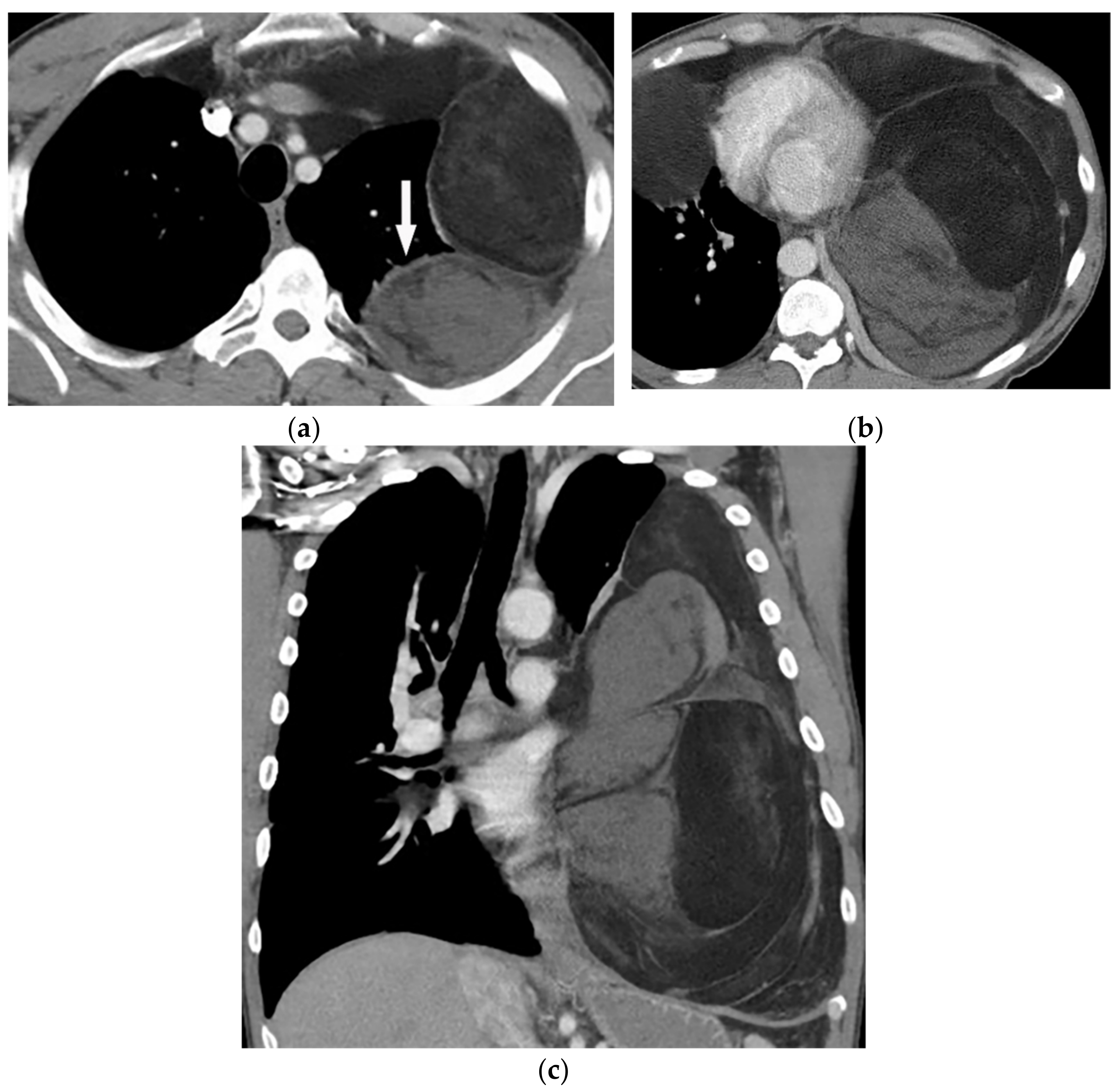
A 58-year-old man with dyspnea. (
) Axial contrast-enhanced CT shows a large heterogeneous mass with enhancing non-adipose solid components (arrow). The mass has extensive fat attenuation that is intermixed with soft tissue density. (
c) Coronal image better characterizes the craniocaudal extension of the mass, which also shows a large inhomogeneous fat-containing lesion with an internal enhancing solid component.
) Coronal image better characterizes the craniocaudal extension of the mass, which also shows a large inhomogeneous fat-containing lesion with an internal enhancing solid component.
5. Pleural Diseases
5.1. Empyema Necessitance
5.1. Empyema Necessitance
Empyema necessitance is a chronic pleural space infection that can affect both immunocompromised and immunocompetent people. Empyema leakage to chest wall soft tissues manifests as an extrapleural collection of empyema. Its usual location is the anterior aspect of the chest wall. Mycobacterium Tuberculosis is the most prevalent pathogen, with Nocardia Asteroides, Actinomyces Israelii, Staphylococcus, Aspergillosis, and Blastomycosis spp. being less common
[1][8][24][25][1,8,52,53].
On CT, a communication between the pleural and extrapleural collection is a pathognomonic finding of empyema necessitans (
Figure 1425). A peripheral rim of soft tissue inflammation and thickening, draining sinus tracts, and rib destruction with periosteal reaction are other radiologic findings. MRI is extremely helpful in detecting vertebral and spinal canal involvement if the posteromedial part of the chest wall is affected (
Table 24)
[26][54].
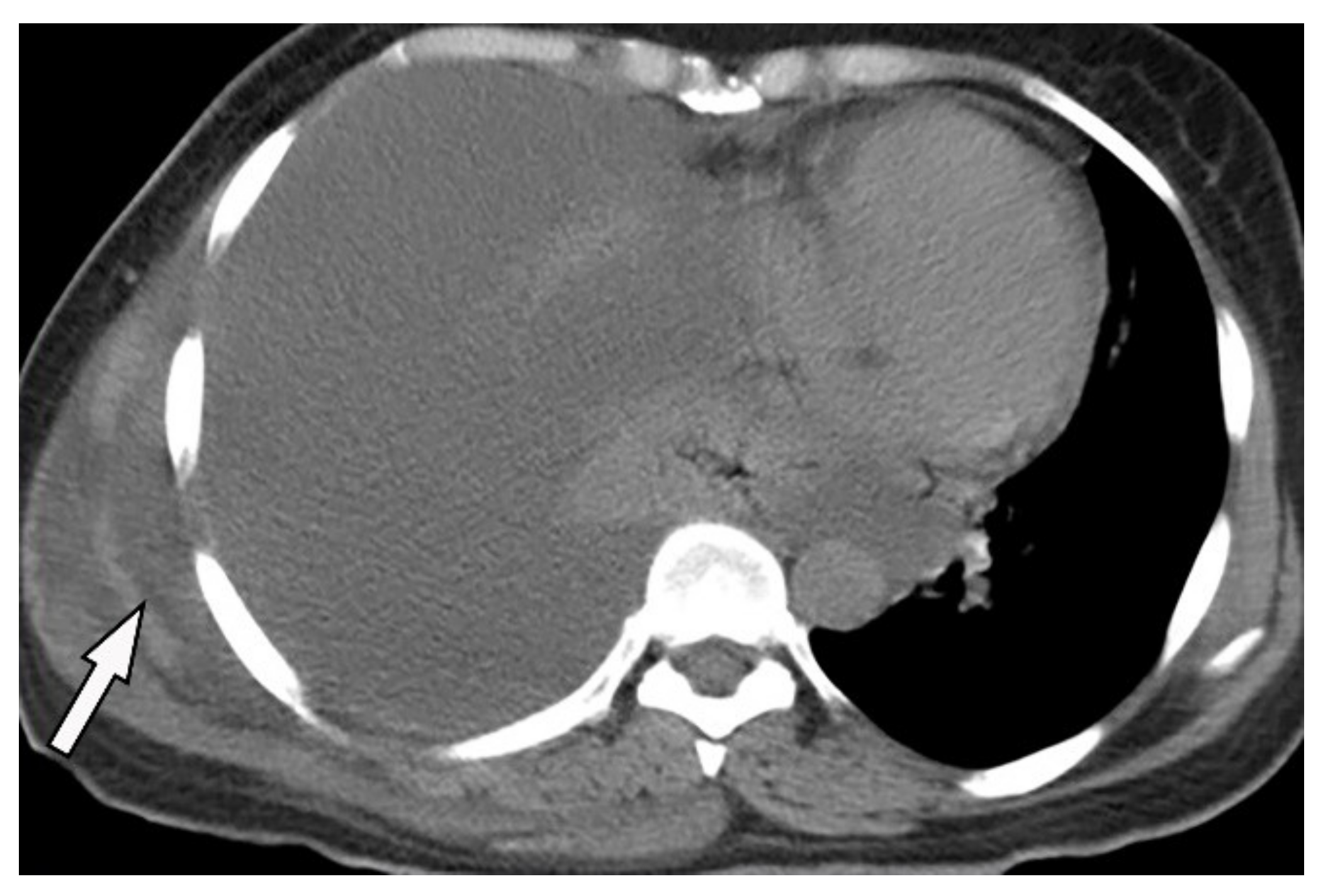
Figure 1425. A 46-year-old man with high-grade fever and chills. The axial contrast-enhanced CT shows significant right-sided pleural effusion with the near complete collapse of the right lung resulting in a shift of the heart and mediastinum to the left side. There is pleural thickening and enhancement. There is an extrapleural component within the adjacent chest wall with rim enhancement (arrow). Aspiration was performed under the guidance of ultrasonography, and diagnosis of empyema necessitans was made as a complication of Actinomyces Israelii.
5.2. Asbestos-Related Pleural Diseases
A 46-year-old man with high-grade fever and chills. The axial contrast-enhanced CT shows significant right-sided pleural effusion with the near complete collapse of the right lung resulting in a shift of the heart and mediastinum to the left side. There is pleural thickening and enhancement. There is an extrapleural component within the adjacent chest wall with rim enhancement (arrow). Aspiration was performed under the guidance of ultrasonography, and diagnosis of empyema necessitans was made as a complication of Actinomyces Israelii.
5.2. Asbestos-Related Pleural Diseases
Asbestos-induced conditions include non-neoplastic and neoplastic pleural and lung diseases ranging from pleural effusion, thickening, plaques to malignant mesothelioma, and lung cancer. Pleural plaques are the most common disease
[19][20][27][48,49,55].
Paravertebral and anterior plaques are better delineated on CT scans than radiography (
Figure 1526). On MRI, pleural plaques are hypo to isointense to skeletal muscle on T1-weighted, and hypointense on T2-weighted images. These findings are representative of fibrosis and internal calcification (
Table 24)
[19][20][27][48,49,55].
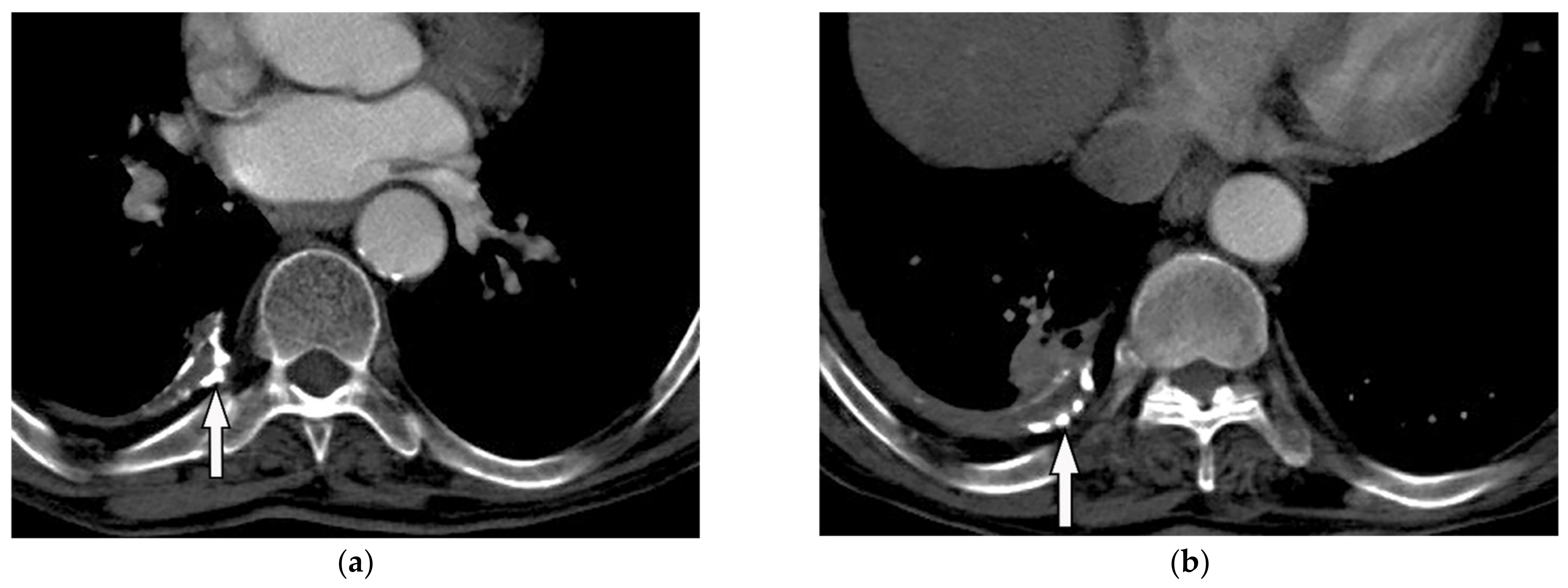
A 78-year-old man with dyspnea. The axial contrast-enhanced CT (
b) demonstrates right-sided calcified pleural plaque (arrow) and small pleural effusion due to previous asbestosis exposure. Adjacent round atelectasis is also shown.
5.3. Mesothelioma
) demonstrates right-sided calcified pleural plaque (arrow) and small pleural effusion due to previous asbestosis exposure. Adjacent round atelectasis is also shown.
Malignant mesothelioma is the most common primary tumor of the pleura, which is related to prior asbestos exposure with a relatively poor prognosis
[28][56].
Multidetector CT effectively reveals the primary tumoral extension, lymphadenopathy, and extrathoracic metastasis (
Figure 1627 and
Figure 1728)
[28][56]. Another CT finding is circumferential pleural thickening (most common finding) with extension along the fissures. Large or punctate osseous or cartilaginous differentiation is more in favor of malignant mesothelioma rather than linear calcification that usually occurs within asbestosis plaques. Dynamic contrast-enhanced computed tomography (DCE CT) enables measuring intratumoral capillary permeability and blood flow, which are beneficial in evaluating treatment response
[28][29][30][56,57,58].
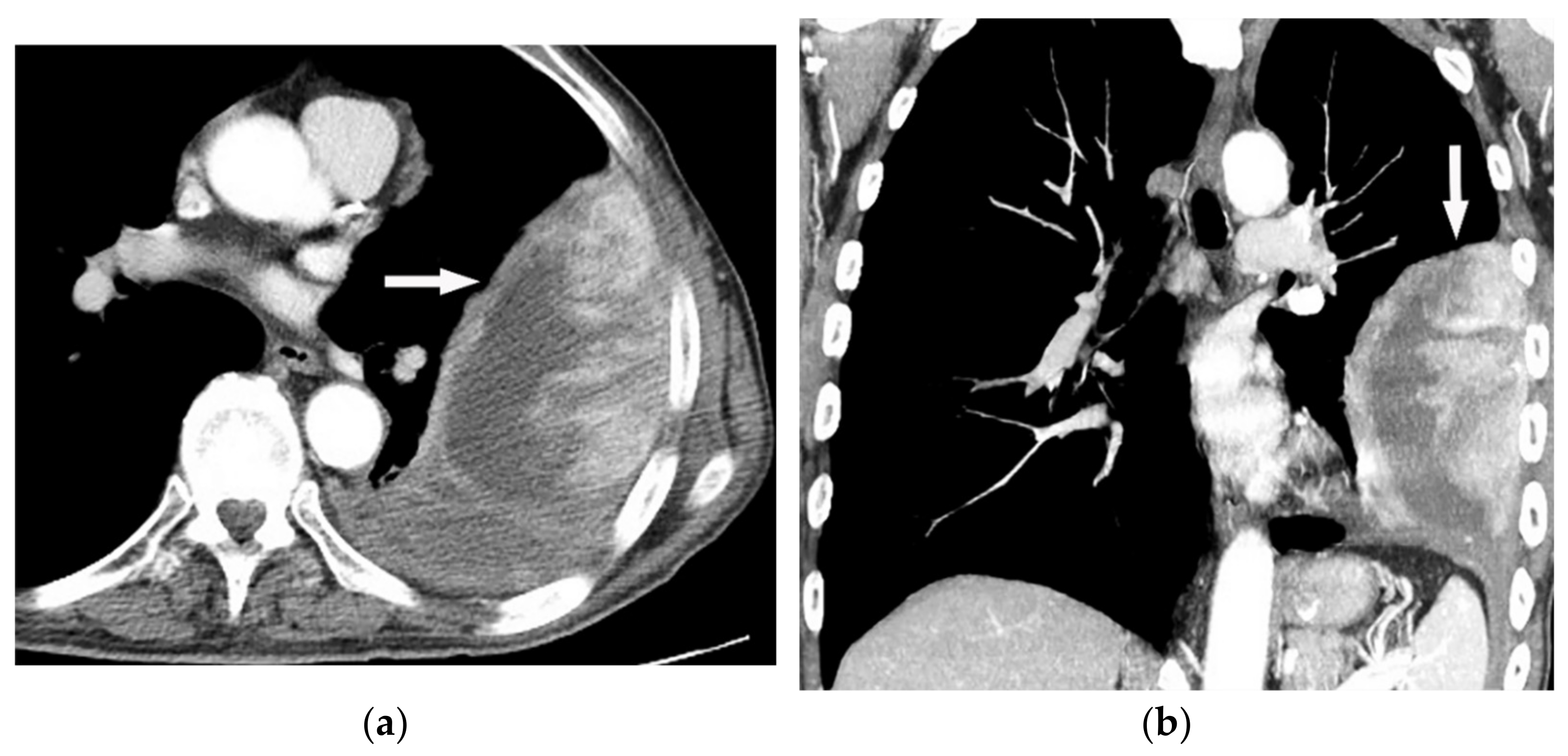
A 67-year-old man with dyspnea and chest pain. Contrast-enhanced CT in axial (
b) planes demonstrate left-sided localized enhancing pleural mass (arrow) with internal areas of necrosis that extend to the posteromedial aspect of the chest wall. Involvement of diaphragmatic pleura and elevation of left hemidiaphragm are also identified.
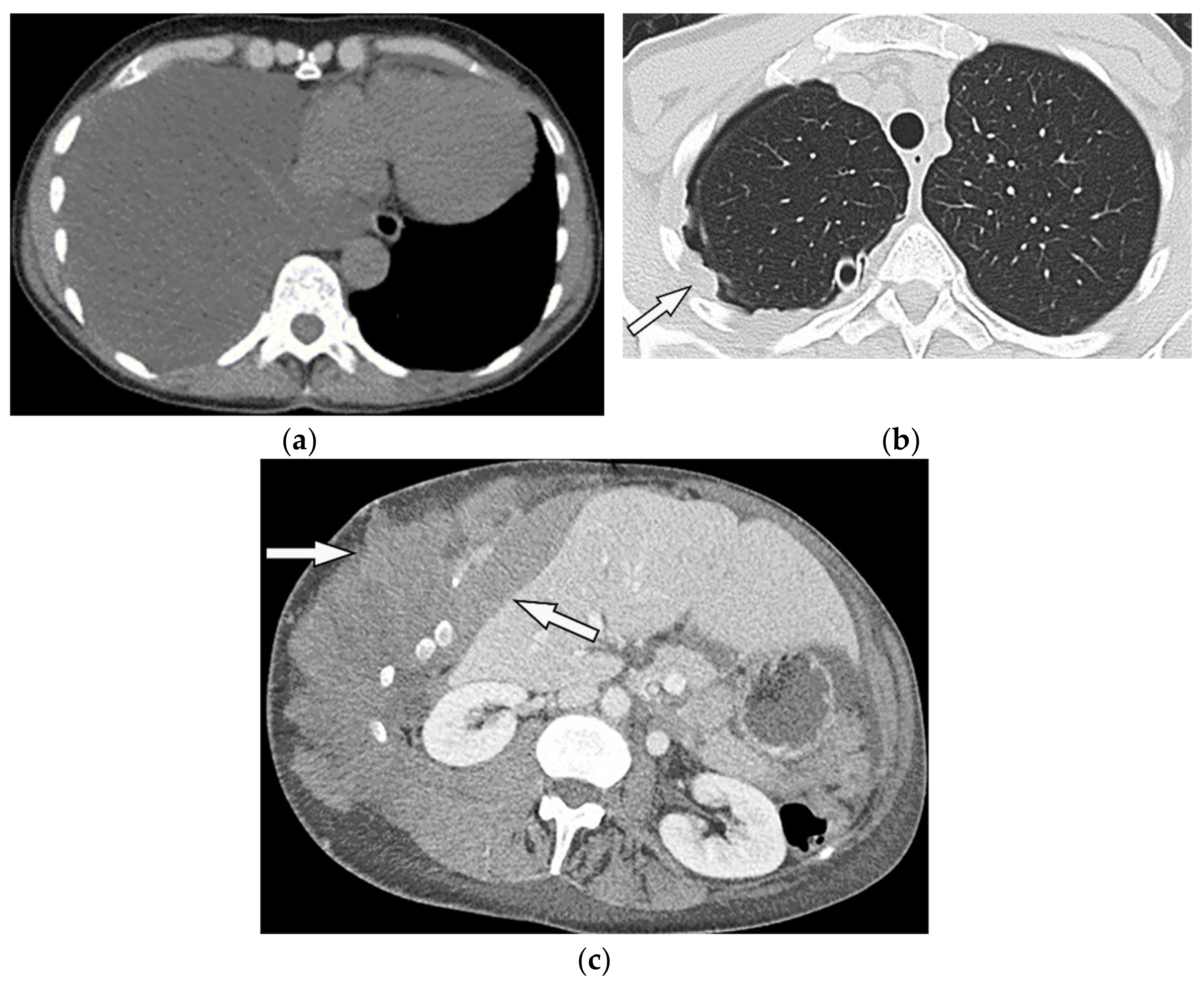
) planes demonstrate left-sided localized enhancing pleural mass (arrow) with internal areas of necrosis that extend to the posteromedial aspect of the chest wall. Involvement of diaphragmatic pleura and elevation of left hemidiaphragm are also identified.
A 70-year-old man with dyspnea. The non-contrast CT in the axial plane demonstrates right-sided large pleural effusion, near complete collapse of the right lung (
) after the chest tube insertion; thick circumferential nodular pleural thickening of parietal pleura was shown (arrow) (
). Contrast-enhanced CT of the upper abdomen shows the extension of mesothelioma through the abdominal cavity and wall with indentation over adjacent liver parenchyma (arrow) (
c).
MR imaging and 18F-FDG PET/CT are useful in further evaluation of chest wall, diaphragm, and mediastinal invasion [28][29][30][31]. Malignant mesothelioma appears as unilateral hyperintense pleural effusion and pleural thickening with iso to slight hyperintensity to chest wall muscles on T1-weighted and moderate hyperintensity on T2-weighted images. Post-contrast enhancement is expected (
MR imaging and 18F-FDG PET/CT are useful in further evaluation of chest wall, diaphragm, and mediastinal invasion [56,57,58,59]. Malignant mesothelioma appears as unilateral hyperintense pleural effusion and pleural thickening with iso to slight hyperintensity to chest wall muscles on T1-weighted and moderate hyperintensity on T2-weighted images. Post-contrast enhancement is expected ( Table 1). It is believed that higher metabolic activity on 18F-FDG PET/CT is associated with poor prognosis and shorter survival time [21][28][29][30].
3). It is believed that higher metabolic activity on 18F-FDG PET/CT is associated with poor prognosis and shorter survival time [25,56,57,58].

